Assignment On Drug Classification And Preparation Of Clients For Detoxification
VerifiedAdded on 2022/10/04
|24
|5510
|12
Assignment
AI Summary
Contribute Materials
Your contribution can guide someone’s learning journey. Share your
documents today.
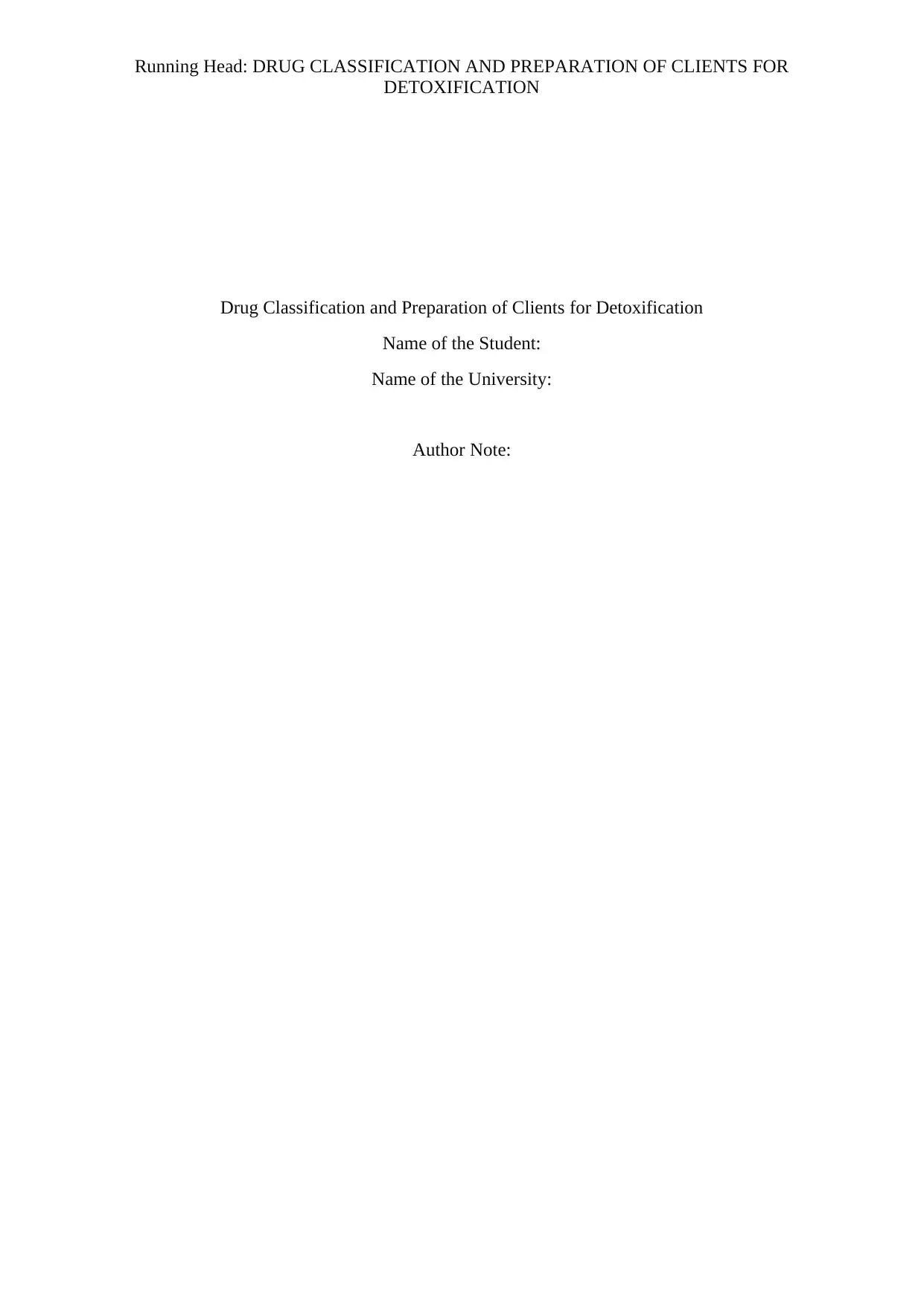
Running Head: DRUG CLASSIFICATION AND PREPARATION OF CLIENTS FOR
DETOXIFICATION
Drug Classification and Preparation of Clients for Detoxification
Name of the Student:
Name of the University:
Author Note:
DETOXIFICATION
Drug Classification and Preparation of Clients for Detoxification
Name of the Student:
Name of the University:
Author Note:
Secure Best Marks with AI Grader
Need help grading? Try our AI Grader for instant feedback on your assignments.

1Drug Classification and Preparation of Clients for Detoxification
Table of Contents
Assessment Task 1.....................................................................................................................2
Part A:....................................................................................................................................2
Part B:.....................................................................................................................................2
Assessment task 2......................................................................................................................4
Assessment task 3......................................................................................................................6
Part A.....................................................................................................................................6
Managing Alcohol Withdrawal..............................................................................................7
Assessment task 4....................................................................................................................10
Part A...................................................................................................................................10
Part B....................................................................................................................................16
Table of Contents
Assessment Task 1.....................................................................................................................2
Part A:....................................................................................................................................2
Part B:.....................................................................................................................................2
Assessment task 2......................................................................................................................4
Assessment task 3......................................................................................................................6
Part A.....................................................................................................................................6
Managing Alcohol Withdrawal..............................................................................................7
Assessment task 4....................................................................................................................10
Part A...................................................................................................................................10
Part B....................................................................................................................................16
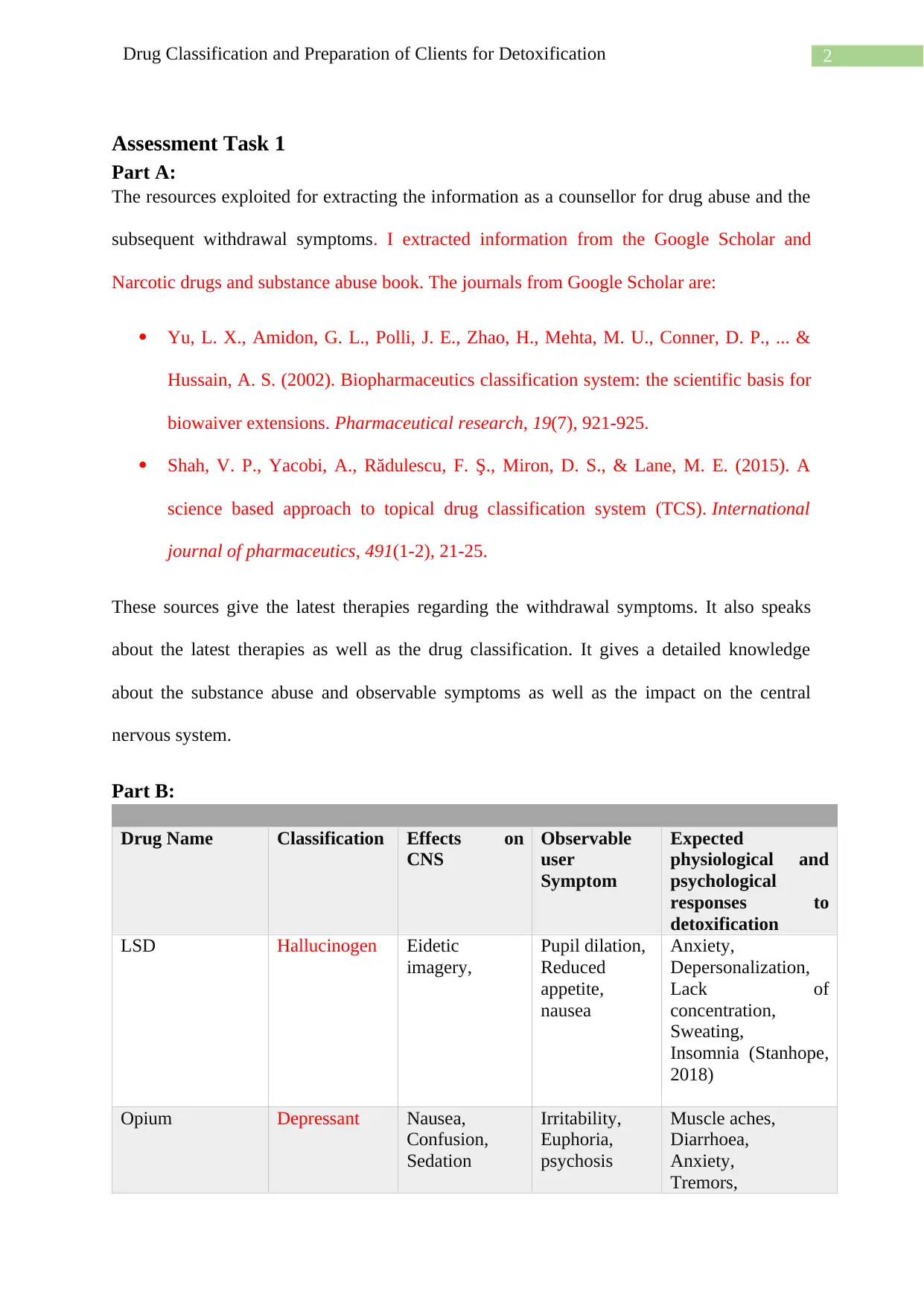
2Drug Classification and Preparation of Clients for Detoxification
Assessment Task 1
Part A:
The resources exploited for extracting the information as a counsellor for drug abuse and the
subsequent withdrawal symptoms. I extracted information from the Google Scholar and
Narcotic drugs and substance abuse book. The journals from Google Scholar are:
Yu, L. X., Amidon, G. L., Polli, J. E., Zhao, H., Mehta, M. U., Conner, D. P., ... &
Hussain, A. S. (2002). Biopharmaceutics classification system: the scientific basis for
biowaiver extensions. Pharmaceutical research, 19(7), 921-925.
Shah, V. P., Yacobi, A., Rădulescu, F. Ş., Miron, D. S., & Lane, M. E. (2015). A
science based approach to topical drug classification system (TCS). International
journal of pharmaceutics, 491(1-2), 21-25.
These sources give the latest therapies regarding the withdrawal symptoms. It also speaks
about the latest therapies as well as the drug classification. It gives a detailed knowledge
about the substance abuse and observable symptoms as well as the impact on the central
nervous system.
Part B:
Drug Name Classification Effects on
CNS
Observable
user
Symptom
Expected
physiological and
psychological
responses to
detoxification
LSD Hallucinogen Eidetic
imagery,
Pupil dilation,
Reduced
appetite,
nausea
Anxiety,
Depersonalization,
Lack of
concentration,
Sweating,
Insomnia (Stanhope,
2018)
Opium Depressant Nausea,
Confusion,
Sedation
Irritability,
Euphoria,
psychosis
Muscle aches,
Diarrhoea,
Anxiety,
Tremors,
Assessment Task 1
Part A:
The resources exploited for extracting the information as a counsellor for drug abuse and the
subsequent withdrawal symptoms. I extracted information from the Google Scholar and
Narcotic drugs and substance abuse book. The journals from Google Scholar are:
Yu, L. X., Amidon, G. L., Polli, J. E., Zhao, H., Mehta, M. U., Conner, D. P., ... &
Hussain, A. S. (2002). Biopharmaceutics classification system: the scientific basis for
biowaiver extensions. Pharmaceutical research, 19(7), 921-925.
Shah, V. P., Yacobi, A., Rădulescu, F. Ş., Miron, D. S., & Lane, M. E. (2015). A
science based approach to topical drug classification system (TCS). International
journal of pharmaceutics, 491(1-2), 21-25.
These sources give the latest therapies regarding the withdrawal symptoms. It also speaks
about the latest therapies as well as the drug classification. It gives a detailed knowledge
about the substance abuse and observable symptoms as well as the impact on the central
nervous system.
Part B:
Drug Name Classification Effects on
CNS
Observable
user
Symptom
Expected
physiological and
psychological
responses to
detoxification
LSD Hallucinogen Eidetic
imagery,
Pupil dilation,
Reduced
appetite,
nausea
Anxiety,
Depersonalization,
Lack of
concentration,
Sweating,
Insomnia (Stanhope,
2018)
Opium Depressant Nausea,
Confusion,
Sedation
Irritability,
Euphoria,
psychosis
Muscle aches,
Diarrhoea,
Anxiety,
Tremors,

3Drug Classification and Preparation of Clients for Detoxification
Agitation (Terry,
Plagenhoef &
Callahan, 2016)
Vodka Depressant Impaired
cognition and
memory,
Destroys brain
cells, depresses
CNS (Barr,
Helms, Grant
& Messaoudi,
2016)
Incoherent
speech,
Delayed
reflexes,
Loss of
consciousness
Irritability,
Increased heart rate,
Sweating,
Nausea,
Tremors
PCP Hallucinogen Impaired motor
functions,
interacts with
dopamine,
auditory and
visual
distortions,
memory loss,
anxiety
Sedation,
Amnesia,
Blank stare
Weight loss,
Speech impairment,
Impaired cognitive
function,
Muscle twitching,
hallucinations
Amphetamine/
Methamphetamine
Stimulant CNS
stimulants,
Improved
concentration
ability, stay
awake,
increases blood
pressure and
heart rate.
Aggression,
Paranoia,
Digestive
upset
Impaired social
functioning,
Depressed moods,
Aches and pains,
irritability
Morphine Narcotic Analgesia,
impacts
digestion and
blood
circulation,
increased blood
pressure,
impacts
conscious
thoughts
Impaired
mental
performance,
Tolerance,
Decreased
hunger
Chills,
Watery eyes,
Nausea,
Insomnia,
depression
Rohypnol Depressant Binds to
gamma
aminobutyric
acid, reduces
neuronal
activity,
depresses the
central nervous
system,
drowsiness,
Nausea,
Dizziness,
confusion
Delirium,
Loss of identity,
Muscle pain,
Shock,
Cardiovascular
distress
Agitation (Terry,
Plagenhoef &
Callahan, 2016)
Vodka Depressant Impaired
cognition and
memory,
Destroys brain
cells, depresses
CNS (Barr,
Helms, Grant
& Messaoudi,
2016)
Incoherent
speech,
Delayed
reflexes,
Loss of
consciousness
Irritability,
Increased heart rate,
Sweating,
Nausea,
Tremors
PCP Hallucinogen Impaired motor
functions,
interacts with
dopamine,
auditory and
visual
distortions,
memory loss,
anxiety
Sedation,
Amnesia,
Blank stare
Weight loss,
Speech impairment,
Impaired cognitive
function,
Muscle twitching,
hallucinations
Amphetamine/
Methamphetamine
Stimulant CNS
stimulants,
Improved
concentration
ability, stay
awake,
increases blood
pressure and
heart rate.
Aggression,
Paranoia,
Digestive
upset
Impaired social
functioning,
Depressed moods,
Aches and pains,
irritability
Morphine Narcotic Analgesia,
impacts
digestion and
blood
circulation,
increased blood
pressure,
impacts
conscious
thoughts
Impaired
mental
performance,
Tolerance,
Decreased
hunger
Chills,
Watery eyes,
Nausea,
Insomnia,
depression
Rohypnol Depressant Binds to
gamma
aminobutyric
acid, reduces
neuronal
activity,
depresses the
central nervous
system,
drowsiness,
Nausea,
Dizziness,
confusion
Delirium,
Loss of identity,
Muscle pain,
Shock,
Cardiovascular
distress
Secure Best Marks with AI Grader
Need help grading? Try our AI Grader for instant feedback on your assignments.
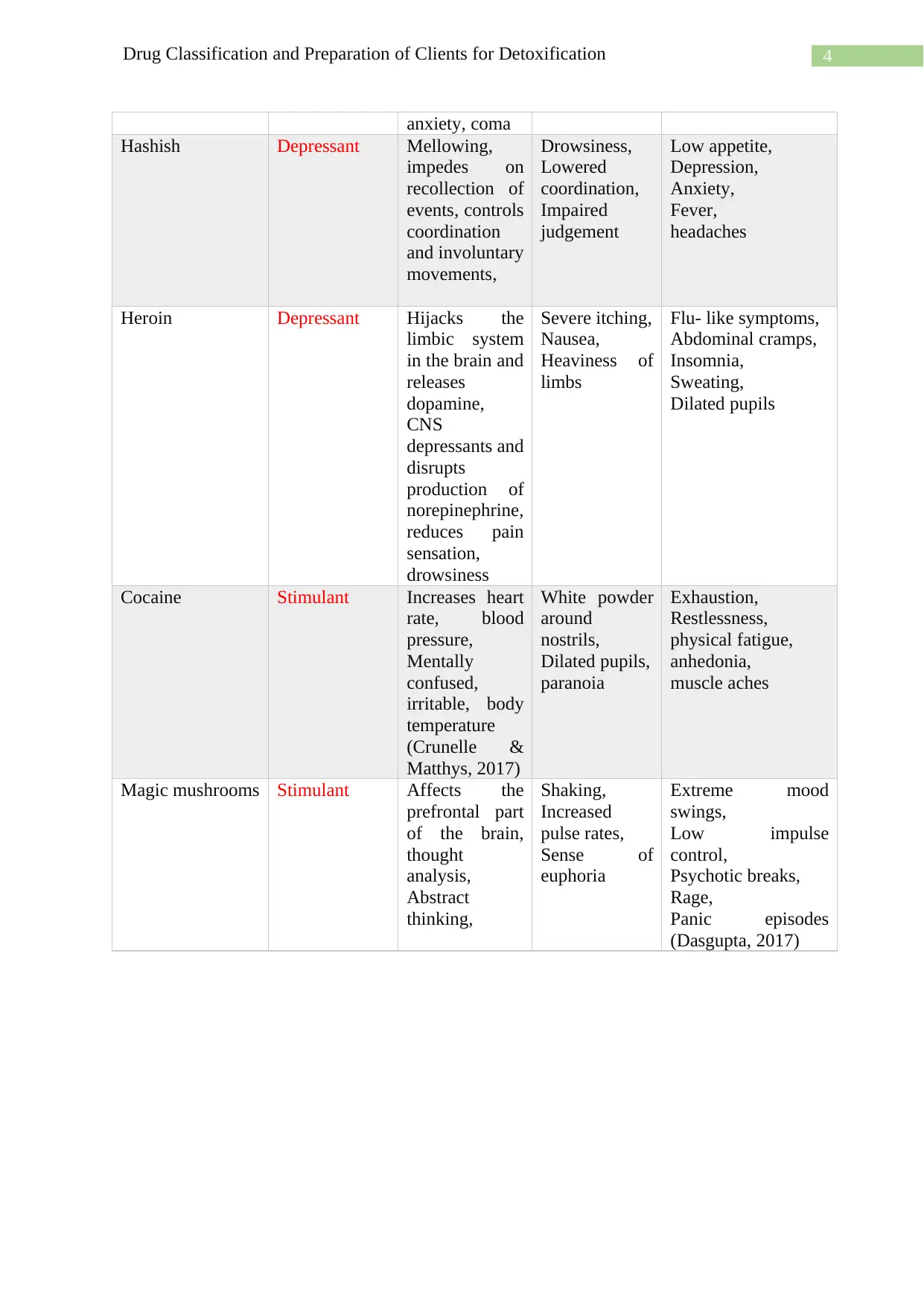
4Drug Classification and Preparation of Clients for Detoxification
anxiety, coma
Hashish Depressant Mellowing,
impedes on
recollection of
events, controls
coordination
and involuntary
movements,
Drowsiness,
Lowered
coordination,
Impaired
judgement
Low appetite,
Depression,
Anxiety,
Fever,
headaches
Heroin Depressant Hijacks the
limbic system
in the brain and
releases
dopamine,
CNS
depressants and
disrupts
production of
norepinephrine,
reduces pain
sensation,
drowsiness
Severe itching,
Nausea,
Heaviness of
limbs
Flu- like symptoms,
Abdominal cramps,
Insomnia,
Sweating,
Dilated pupils
Cocaine Stimulant Increases heart
rate, blood
pressure,
Mentally
confused,
irritable, body
temperature
(Crunelle &
Matthys, 2017)
White powder
around
nostrils,
Dilated pupils,
paranoia
Exhaustion,
Restlessness,
physical fatigue,
anhedonia,
muscle aches
Magic mushrooms Stimulant Affects the
prefrontal part
of the brain,
thought
analysis,
Abstract
thinking,
Shaking,
Increased
pulse rates,
Sense of
euphoria
Extreme mood
swings,
Low impulse
control,
Psychotic breaks,
Rage,
Panic episodes
(Dasgupta, 2017)
anxiety, coma
Hashish Depressant Mellowing,
impedes on
recollection of
events, controls
coordination
and involuntary
movements,
Drowsiness,
Lowered
coordination,
Impaired
judgement
Low appetite,
Depression,
Anxiety,
Fever,
headaches
Heroin Depressant Hijacks the
limbic system
in the brain and
releases
dopamine,
CNS
depressants and
disrupts
production of
norepinephrine,
reduces pain
sensation,
drowsiness
Severe itching,
Nausea,
Heaviness of
limbs
Flu- like symptoms,
Abdominal cramps,
Insomnia,
Sweating,
Dilated pupils
Cocaine Stimulant Increases heart
rate, blood
pressure,
Mentally
confused,
irritable, body
temperature
(Crunelle &
Matthys, 2017)
White powder
around
nostrils,
Dilated pupils,
paranoia
Exhaustion,
Restlessness,
physical fatigue,
anhedonia,
muscle aches
Magic mushrooms Stimulant Affects the
prefrontal part
of the brain,
thought
analysis,
Abstract
thinking,
Shaking,
Increased
pulse rates,
Sense of
euphoria
Extreme mood
swings,
Low impulse
control,
Psychotic breaks,
Rage,
Panic episodes
(Dasgupta, 2017)
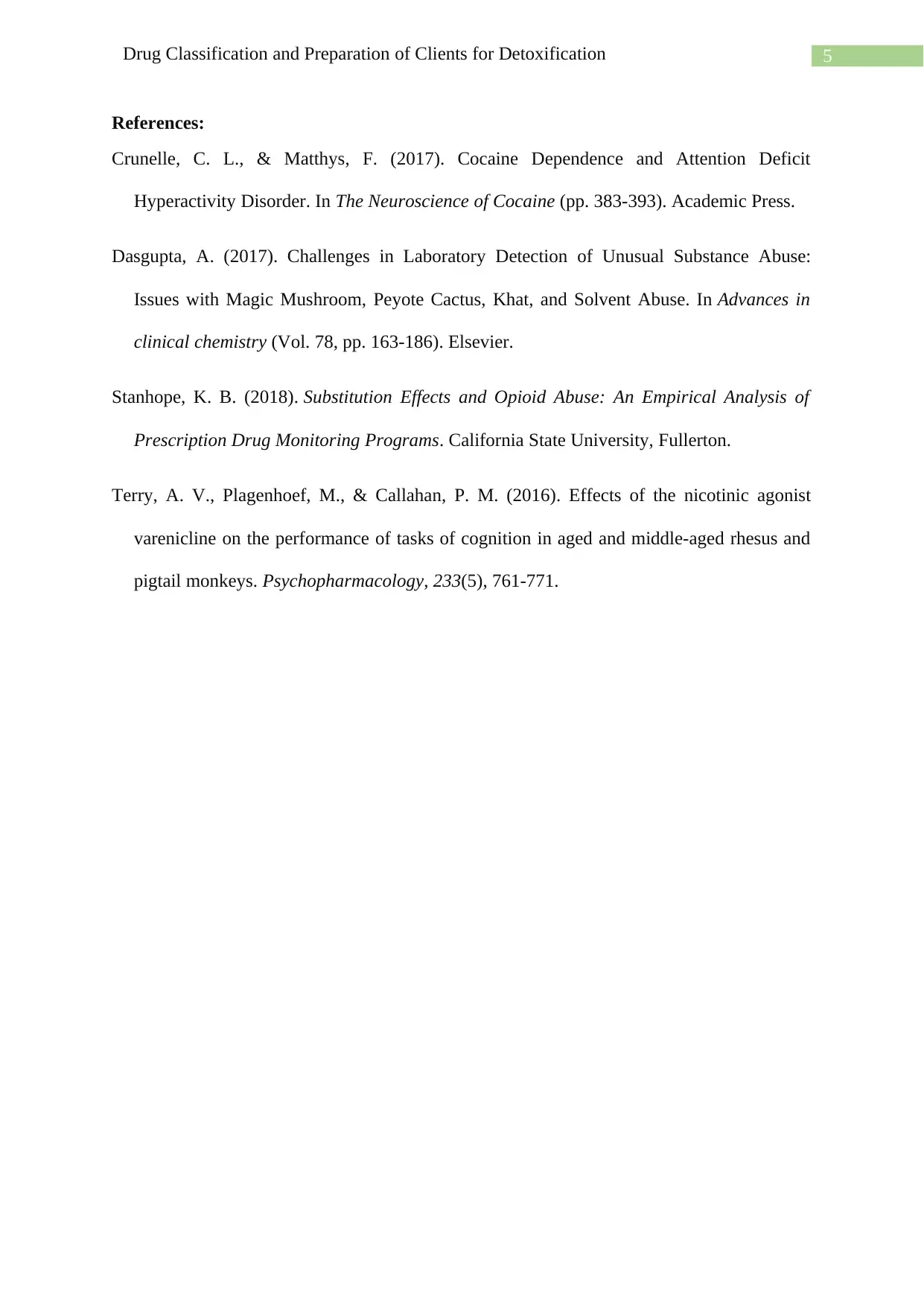
5Drug Classification and Preparation of Clients for Detoxification
References:
Crunelle, C. L., & Matthys, F. (2017). Cocaine Dependence and Attention Deficit
Hyperactivity Disorder. In The Neuroscience of Cocaine (pp. 383-393). Academic Press.
Dasgupta, A. (2017). Challenges in Laboratory Detection of Unusual Substance Abuse:
Issues with Magic Mushroom, Peyote Cactus, Khat, and Solvent Abuse. In Advances in
clinical chemistry (Vol. 78, pp. 163-186). Elsevier.
Stanhope, K. B. (2018). Substitution Effects and Opioid Abuse: An Empirical Analysis of
Prescription Drug Monitoring Programs. California State University, Fullerton.
Terry, A. V., Plagenhoef, M., & Callahan, P. M. (2016). Effects of the nicotinic agonist
varenicline on the performance of tasks of cognition in aged and middle-aged rhesus and
pigtail monkeys. Psychopharmacology, 233(5), 761-771.
References:
Crunelle, C. L., & Matthys, F. (2017). Cocaine Dependence and Attention Deficit
Hyperactivity Disorder. In The Neuroscience of Cocaine (pp. 383-393). Academic Press.
Dasgupta, A. (2017). Challenges in Laboratory Detection of Unusual Substance Abuse:
Issues with Magic Mushroom, Peyote Cactus, Khat, and Solvent Abuse. In Advances in
clinical chemistry (Vol. 78, pp. 163-186). Elsevier.
Stanhope, K. B. (2018). Substitution Effects and Opioid Abuse: An Empirical Analysis of
Prescription Drug Monitoring Programs. California State University, Fullerton.
Terry, A. V., Plagenhoef, M., & Callahan, P. M. (2016). Effects of the nicotinic agonist
varenicline on the performance of tasks of cognition in aged and middle-aged rhesus and
pigtail monkeys. Psychopharmacology, 233(5), 761-771.

6Drug Classification and Preparation of Clients for Detoxification
Assessment task 2
Case Study 1:
Brian was into substance abuse of marijuana. Marijuana is a depressant but it possesses the
characteristics of hallucinogen and stimulant as well. It is a cannabinoid.
The typical symptoms of marijuana abuse included red, blurry, blood shot eyes as observed in
Brian (Uhegwu et al., 2015). According to the counsellor Brian had red, blood shot and
lacked concentration on one subject for a prolonged period of time. Brian showed an increase
in appetite and munched on chips ravenously. Marijuana promotes hunger (Rowley et al.,
2017). He had thinking issue which is a behavioural change that is observed in marijuana
addicted individuals. Marijuana intoxication induces inappropriate laughter. Brian had
depicted similar signs while he was about to sign the visitor register the pen dropped from his
hand and while making an attempt to pick it up he kept laughing. Loss of interest and
motivation is also aggravated by marijuana intoxication. Poor coordination is frequently
observed as a symptom of marijuana addiction. The effect of marijuana abuse causes
sleeplessness, anxiety and depression. Brian was reported to suffer from similar symptoms of
keeping awake for long periods at night and he was also paranoid of the sounds that he had
been hearing at night.
Case study 2:
John suffers from heroin addiction. Heroin is a depressant that is an opioid drug which can
either be injected, sniffed, snorted or smoked.
The symptoms exhibited by John showed that he misses appointments and was relaxed. He
resorted to slow speaking and even exhibited slow movement. He was in a dream like state as
stated by the counsellor. He also had itching issues and was unaware of his surroundings.
There was observable weight loss. He also suffered from cold, flu and runny nose. He also
had watery eyes and aching limbs.
Assessment task 2
Case Study 1:
Brian was into substance abuse of marijuana. Marijuana is a depressant but it possesses the
characteristics of hallucinogen and stimulant as well. It is a cannabinoid.
The typical symptoms of marijuana abuse included red, blurry, blood shot eyes as observed in
Brian (Uhegwu et al., 2015). According to the counsellor Brian had red, blood shot and
lacked concentration on one subject for a prolonged period of time. Brian showed an increase
in appetite and munched on chips ravenously. Marijuana promotes hunger (Rowley et al.,
2017). He had thinking issue which is a behavioural change that is observed in marijuana
addicted individuals. Marijuana intoxication induces inappropriate laughter. Brian had
depicted similar signs while he was about to sign the visitor register the pen dropped from his
hand and while making an attempt to pick it up he kept laughing. Loss of interest and
motivation is also aggravated by marijuana intoxication. Poor coordination is frequently
observed as a symptom of marijuana addiction. The effect of marijuana abuse causes
sleeplessness, anxiety and depression. Brian was reported to suffer from similar symptoms of
keeping awake for long periods at night and he was also paranoid of the sounds that he had
been hearing at night.
Case study 2:
John suffers from heroin addiction. Heroin is a depressant that is an opioid drug which can
either be injected, sniffed, snorted or smoked.
The symptoms exhibited by John showed that he misses appointments and was relaxed. He
resorted to slow speaking and even exhibited slow movement. He was in a dream like state as
stated by the counsellor. He also had itching issues and was unaware of his surroundings.
There was observable weight loss. He also suffered from cold, flu and runny nose. He also
had watery eyes and aching limbs.
Paraphrase This Document
Need a fresh take? Get an instant paraphrase of this document with our AI Paraphraser

7Drug Classification and Preparation of Clients for Detoxification
Heroin intake makes a person feel good, happy and contented immediately after intake (Hser
et al., 2015). It induces a feeling of the individual is in a dream and may cause the individual
to think and walk slowly. Abusers intaking heroin are often anxious and have symptoms of
itching (Maas, Madea & Hess, 2018). The drug can promote nausea and vomiting (Dart et al.,
2015).
Case study 3:
Janice is into substance abuse exploiting barbiturates and other hypnotics. These drugs
belong to a class called sedative hypnotics.
Janice has problems leaving the house and seeing the counsellor, she would often cancel her
appointments, Janice is finding it difficult to sober herself and get a better life even if she
wants to. She feels her substance can only calm her down. Her anxiety level increases and she
resorts to her substance. It is only then that things try to become normal for her and she faces
the real world. She mentioned about severe depression and she felt difficulty in getting up
from the bed. She lost her balance, her memory failed, her words also slurred. She had
difficulty in placing the bag beside her and resorted to a taxi instead of taking a bus due to
lack of confidence.
Barbiturates or hypnotics are drugs that causes symptoms of drowsiness and slurred speech.
According to the counsellor Janice suffered from slurred speech (Dumps, Halbeck &
Bolkenius, 2018). Lack of coordination which is also an important symptom was observed in
Janice as she had difficulty in keeping her bag. The falls and dizziness were also seen in
Janice which is due to barbiturates abuse. Involuntary eye movement made her decide to go
in a taxi rather than bus.
Case study 4:
Dan was into cocaine addiction. Cocaine is classified as a stimulant.
Heroin intake makes a person feel good, happy and contented immediately after intake (Hser
et al., 2015). It induces a feeling of the individual is in a dream and may cause the individual
to think and walk slowly. Abusers intaking heroin are often anxious and have symptoms of
itching (Maas, Madea & Hess, 2018). The drug can promote nausea and vomiting (Dart et al.,
2015).
Case study 3:
Janice is into substance abuse exploiting barbiturates and other hypnotics. These drugs
belong to a class called sedative hypnotics.
Janice has problems leaving the house and seeing the counsellor, she would often cancel her
appointments, Janice is finding it difficult to sober herself and get a better life even if she
wants to. She feels her substance can only calm her down. Her anxiety level increases and she
resorts to her substance. It is only then that things try to become normal for her and she faces
the real world. She mentioned about severe depression and she felt difficulty in getting up
from the bed. She lost her balance, her memory failed, her words also slurred. She had
difficulty in placing the bag beside her and resorted to a taxi instead of taking a bus due to
lack of confidence.
Barbiturates or hypnotics are drugs that causes symptoms of drowsiness and slurred speech.
According to the counsellor Janice suffered from slurred speech (Dumps, Halbeck &
Bolkenius, 2018). Lack of coordination which is also an important symptom was observed in
Janice as she had difficulty in keeping her bag. The falls and dizziness were also seen in
Janice which is due to barbiturates abuse. Involuntary eye movement made her decide to go
in a taxi rather than bus.
Case study 4:
Dan was into cocaine addiction. Cocaine is classified as a stimulant.
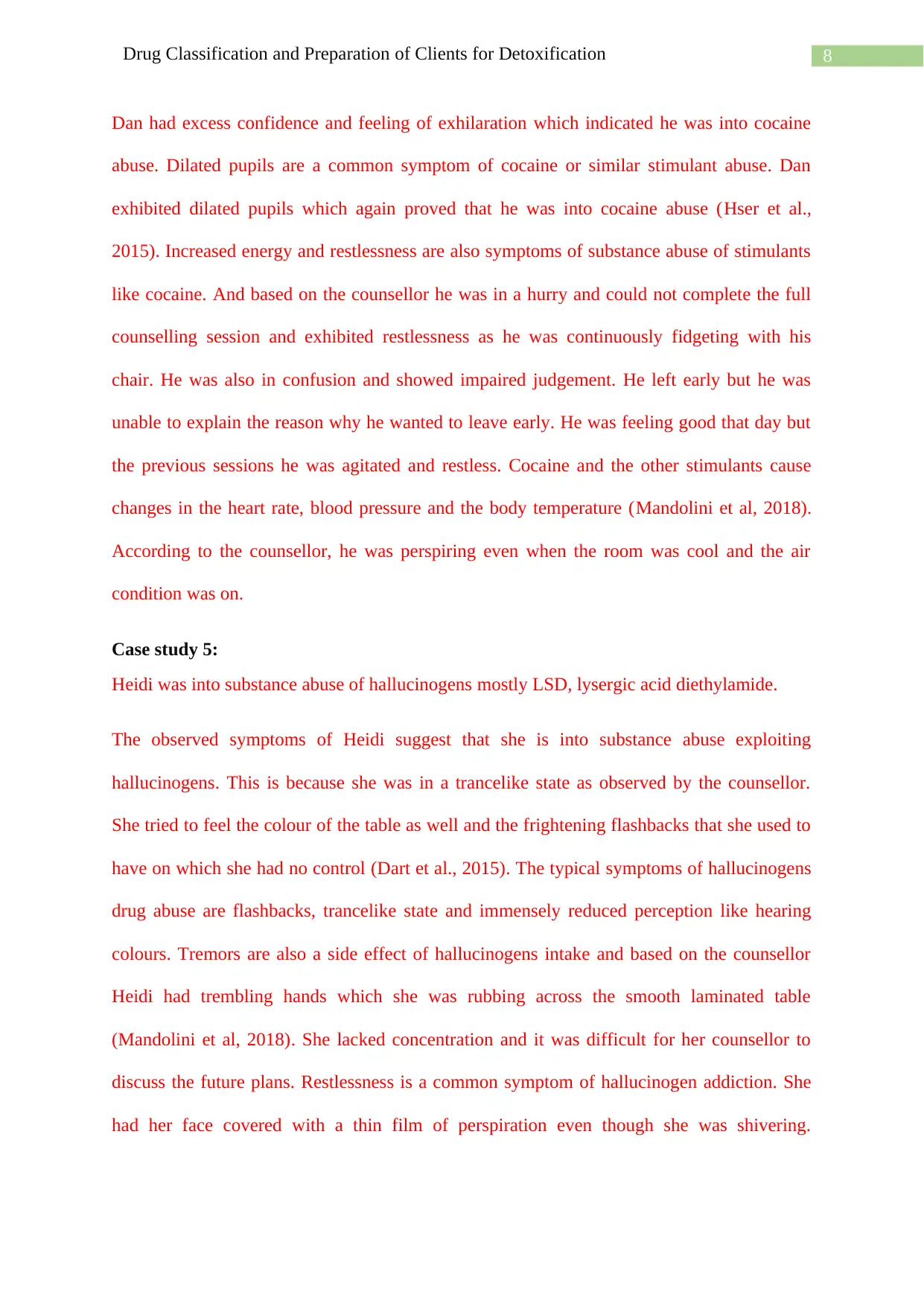
8Drug Classification and Preparation of Clients for Detoxification
Dan had excess confidence and feeling of exhilaration which indicated he was into cocaine
abuse. Dilated pupils are a common symptom of cocaine or similar stimulant abuse. Dan
exhibited dilated pupils which again proved that he was into cocaine abuse (Hser et al.,
2015). Increased energy and restlessness are also symptoms of substance abuse of stimulants
like cocaine. And based on the counsellor he was in a hurry and could not complete the full
counselling session and exhibited restlessness as he was continuously fidgeting with his
chair. He was also in confusion and showed impaired judgement. He left early but he was
unable to explain the reason why he wanted to leave early. He was feeling good that day but
the previous sessions he was agitated and restless. Cocaine and the other stimulants cause
changes in the heart rate, blood pressure and the body temperature (Mandolini et al, 2018).
According to the counsellor, he was perspiring even when the room was cool and the air
condition was on.
Case study 5:
Heidi was into substance abuse of hallucinogens mostly LSD, lysergic acid diethylamide.
The observed symptoms of Heidi suggest that she is into substance abuse exploiting
hallucinogens. This is because she was in a trancelike state as observed by the counsellor.
She tried to feel the colour of the table as well and the frightening flashbacks that she used to
have on which she had no control (Dart et al., 2015). The typical symptoms of hallucinogens
drug abuse are flashbacks, trancelike state and immensely reduced perception like hearing
colours. Tremors are also a side effect of hallucinogens intake and based on the counsellor
Heidi had trembling hands which she was rubbing across the smooth laminated table
(Mandolini et al, 2018). She lacked concentration and it was difficult for her counsellor to
discuss the future plans. Restlessness is a common symptom of hallucinogen addiction. She
had her face covered with a thin film of perspiration even though she was shivering.
Dan had excess confidence and feeling of exhilaration which indicated he was into cocaine
abuse. Dilated pupils are a common symptom of cocaine or similar stimulant abuse. Dan
exhibited dilated pupils which again proved that he was into cocaine abuse (Hser et al.,
2015). Increased energy and restlessness are also symptoms of substance abuse of stimulants
like cocaine. And based on the counsellor he was in a hurry and could not complete the full
counselling session and exhibited restlessness as he was continuously fidgeting with his
chair. He was also in confusion and showed impaired judgement. He left early but he was
unable to explain the reason why he wanted to leave early. He was feeling good that day but
the previous sessions he was agitated and restless. Cocaine and the other stimulants cause
changes in the heart rate, blood pressure and the body temperature (Mandolini et al, 2018).
According to the counsellor, he was perspiring even when the room was cool and the air
condition was on.
Case study 5:
Heidi was into substance abuse of hallucinogens mostly LSD, lysergic acid diethylamide.
The observed symptoms of Heidi suggest that she is into substance abuse exploiting
hallucinogens. This is because she was in a trancelike state as observed by the counsellor.
She tried to feel the colour of the table as well and the frightening flashbacks that she used to
have on which she had no control (Dart et al., 2015). The typical symptoms of hallucinogens
drug abuse are flashbacks, trancelike state and immensely reduced perception like hearing
colours. Tremors are also a side effect of hallucinogens intake and based on the counsellor
Heidi had trembling hands which she was rubbing across the smooth laminated table
(Mandolini et al, 2018). She lacked concentration and it was difficult for her counsellor to
discuss the future plans. Restlessness is a common symptom of hallucinogen addiction. She
had her face covered with a thin film of perspiration even though she was shivering.
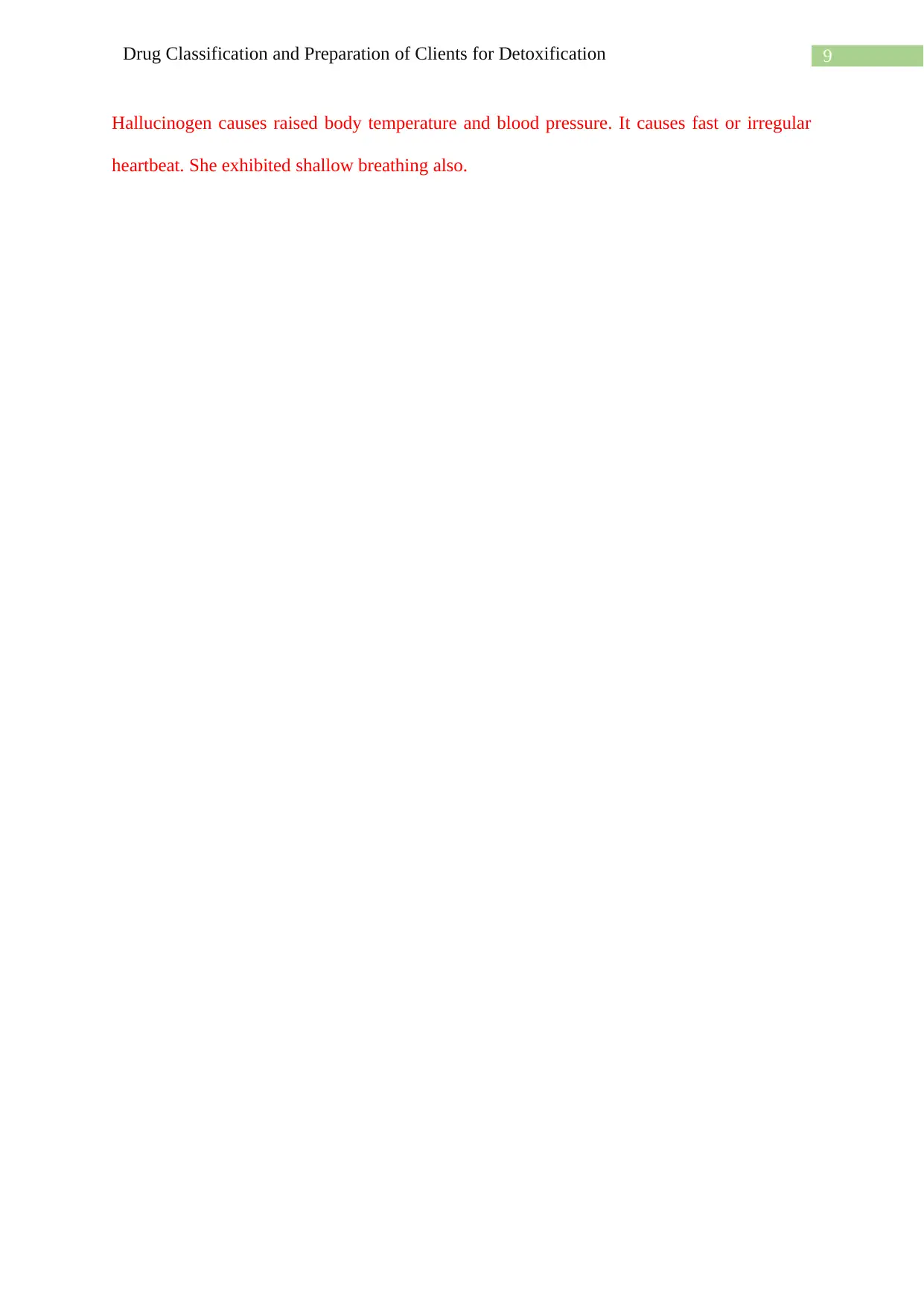
9Drug Classification and Preparation of Clients for Detoxification
Hallucinogen causes raised body temperature and blood pressure. It causes fast or irregular
heartbeat. She exhibited shallow breathing also.
Hallucinogen causes raised body temperature and blood pressure. It causes fast or irregular
heartbeat. She exhibited shallow breathing also.
Secure Best Marks with AI Grader
Need help grading? Try our AI Grader for instant feedback on your assignments.
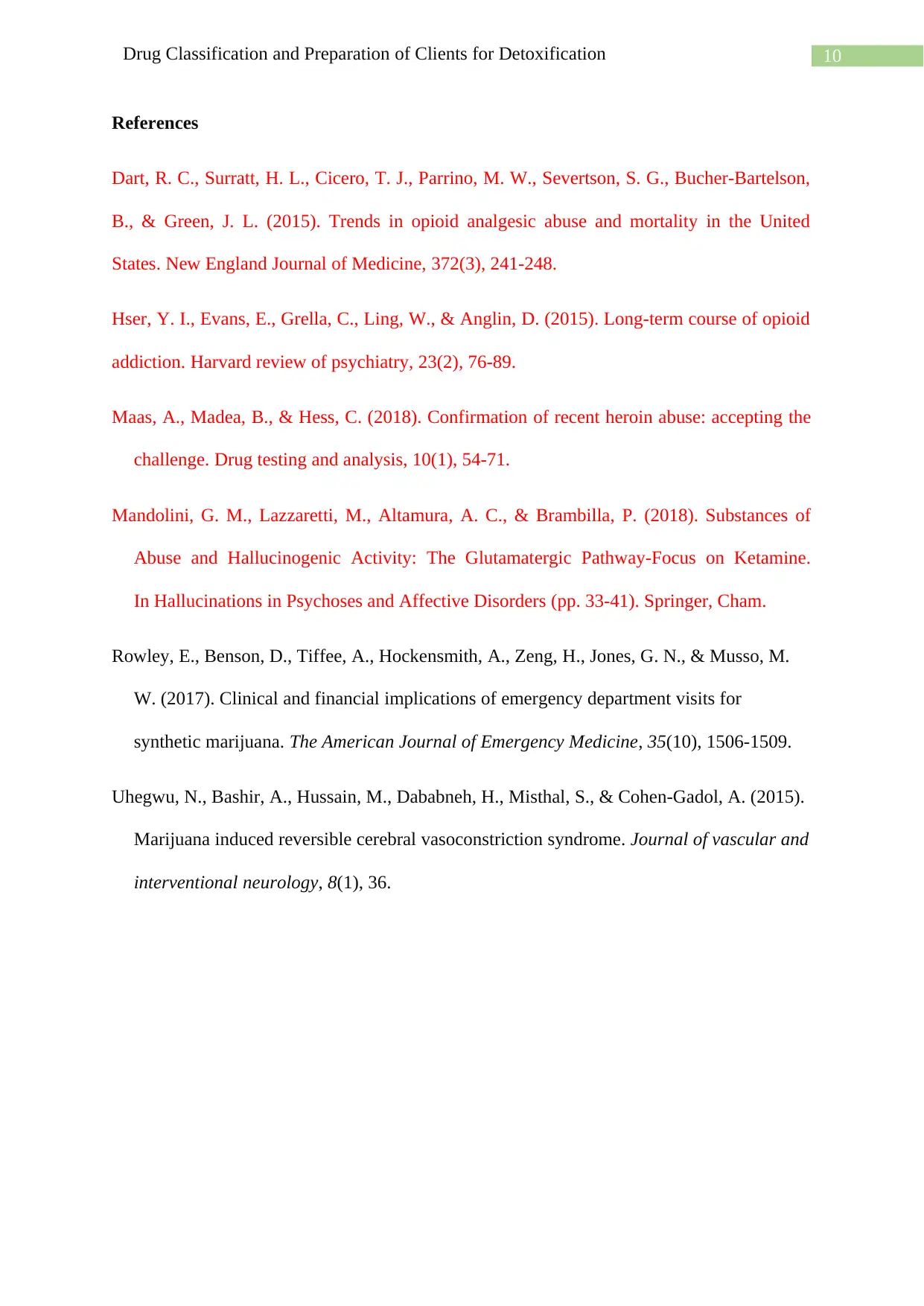
10Drug Classification and Preparation of Clients for Detoxification
References
Dart, R. C., Surratt, H. L., Cicero, T. J., Parrino, M. W., Severtson, S. G., Bucher-Bartelson,
B., & Green, J. L. (2015). Trends in opioid analgesic abuse and mortality in the United
States. New England Journal of Medicine, 372(3), 241-248.
Hser, Y. I., Evans, E., Grella, C., Ling, W., & Anglin, D. (2015). Long-term course of opioid
addiction. Harvard review of psychiatry, 23(2), 76-89.
Maas, A., Madea, B., & Hess, C. (2018). Confirmation of recent heroin abuse: accepting the
challenge. Drug testing and analysis, 10(1), 54-71.
Mandolini, G. M., Lazzaretti, M., Altamura, A. C., & Brambilla, P. (2018). Substances of
Abuse and Hallucinogenic Activity: The Glutamatergic Pathway-Focus on Ketamine.
In Hallucinations in Psychoses and Affective Disorders (pp. 33-41). Springer, Cham.
Rowley, E., Benson, D., Tiffee, A., Hockensmith, A., Zeng, H., Jones, G. N., & Musso, M.
W. (2017). Clinical and financial implications of emergency department visits for
synthetic marijuana. The American Journal of Emergency Medicine, 35(10), 1506-1509.
Uhegwu, N., Bashir, A., Hussain, M., Dababneh, H., Misthal, S., & Cohen-Gadol, A. (2015).
Marijuana induced reversible cerebral vasoconstriction syndrome. Journal of vascular and
interventional neurology, 8(1), 36.
References
Dart, R. C., Surratt, H. L., Cicero, T. J., Parrino, M. W., Severtson, S. G., Bucher-Bartelson,
B., & Green, J. L. (2015). Trends in opioid analgesic abuse and mortality in the United
States. New England Journal of Medicine, 372(3), 241-248.
Hser, Y. I., Evans, E., Grella, C., Ling, W., & Anglin, D. (2015). Long-term course of opioid
addiction. Harvard review of psychiatry, 23(2), 76-89.
Maas, A., Madea, B., & Hess, C. (2018). Confirmation of recent heroin abuse: accepting the
challenge. Drug testing and analysis, 10(1), 54-71.
Mandolini, G. M., Lazzaretti, M., Altamura, A. C., & Brambilla, P. (2018). Substances of
Abuse and Hallucinogenic Activity: The Glutamatergic Pathway-Focus on Ketamine.
In Hallucinations in Psychoses and Affective Disorders (pp. 33-41). Springer, Cham.
Rowley, E., Benson, D., Tiffee, A., Hockensmith, A., Zeng, H., Jones, G. N., & Musso, M.
W. (2017). Clinical and financial implications of emergency department visits for
synthetic marijuana. The American Journal of Emergency Medicine, 35(10), 1506-1509.
Uhegwu, N., Bashir, A., Hussain, M., Dababneh, H., Misthal, S., & Cohen-Gadol, A. (2015).
Marijuana induced reversible cerebral vasoconstriction syndrome. Journal of vascular and
interventional neurology, 8(1), 36.
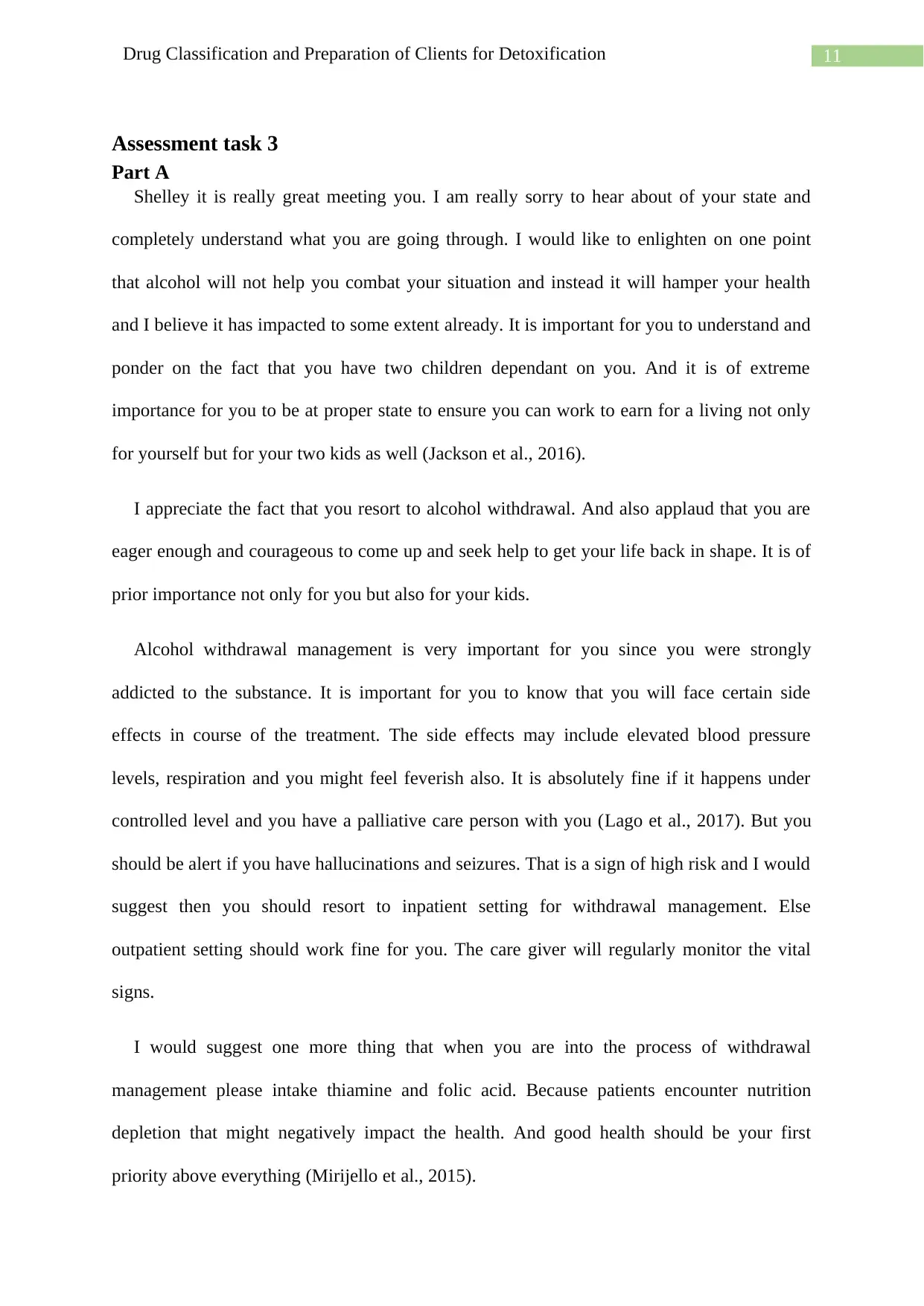
11Drug Classification and Preparation of Clients for Detoxification
Assessment task 3
Part A
Shelley it is really great meeting you. I am really sorry to hear about of your state and
completely understand what you are going through. I would like to enlighten on one point
that alcohol will not help you combat your situation and instead it will hamper your health
and I believe it has impacted to some extent already. It is important for you to understand and
ponder on the fact that you have two children dependant on you. And it is of extreme
importance for you to be at proper state to ensure you can work to earn for a living not only
for yourself but for your two kids as well (Jackson et al., 2016).
I appreciate the fact that you resort to alcohol withdrawal. And also applaud that you are
eager enough and courageous to come up and seek help to get your life back in shape. It is of
prior importance not only for you but also for your kids.
Alcohol withdrawal management is very important for you since you were strongly
addicted to the substance. It is important for you to know that you will face certain side
effects in course of the treatment. The side effects may include elevated blood pressure
levels, respiration and you might feel feverish also. It is absolutely fine if it happens under
controlled level and you have a palliative care person with you (Lago et al., 2017). But you
should be alert if you have hallucinations and seizures. That is a sign of high risk and I would
suggest then you should resort to inpatient setting for withdrawal management. Else
outpatient setting should work fine for you. The care giver will regularly monitor the vital
signs.
I would suggest one more thing that when you are into the process of withdrawal
management please intake thiamine and folic acid. Because patients encounter nutrition
depletion that might negatively impact the health. And good health should be your first
priority above everything (Mirijello et al., 2015).
Assessment task 3
Part A
Shelley it is really great meeting you. I am really sorry to hear about of your state and
completely understand what you are going through. I would like to enlighten on one point
that alcohol will not help you combat your situation and instead it will hamper your health
and I believe it has impacted to some extent already. It is important for you to understand and
ponder on the fact that you have two children dependant on you. And it is of extreme
importance for you to be at proper state to ensure you can work to earn for a living not only
for yourself but for your two kids as well (Jackson et al., 2016).
I appreciate the fact that you resort to alcohol withdrawal. And also applaud that you are
eager enough and courageous to come up and seek help to get your life back in shape. It is of
prior importance not only for you but also for your kids.
Alcohol withdrawal management is very important for you since you were strongly
addicted to the substance. It is important for you to know that you will face certain side
effects in course of the treatment. The side effects may include elevated blood pressure
levels, respiration and you might feel feverish also. It is absolutely fine if it happens under
controlled level and you have a palliative care person with you (Lago et al., 2017). But you
should be alert if you have hallucinations and seizures. That is a sign of high risk and I would
suggest then you should resort to inpatient setting for withdrawal management. Else
outpatient setting should work fine for you. The care giver will regularly monitor the vital
signs.
I would suggest one more thing that when you are into the process of withdrawal
management please intake thiamine and folic acid. Because patients encounter nutrition
depletion that might negatively impact the health. And good health should be your first
priority above everything (Mirijello et al., 2015).
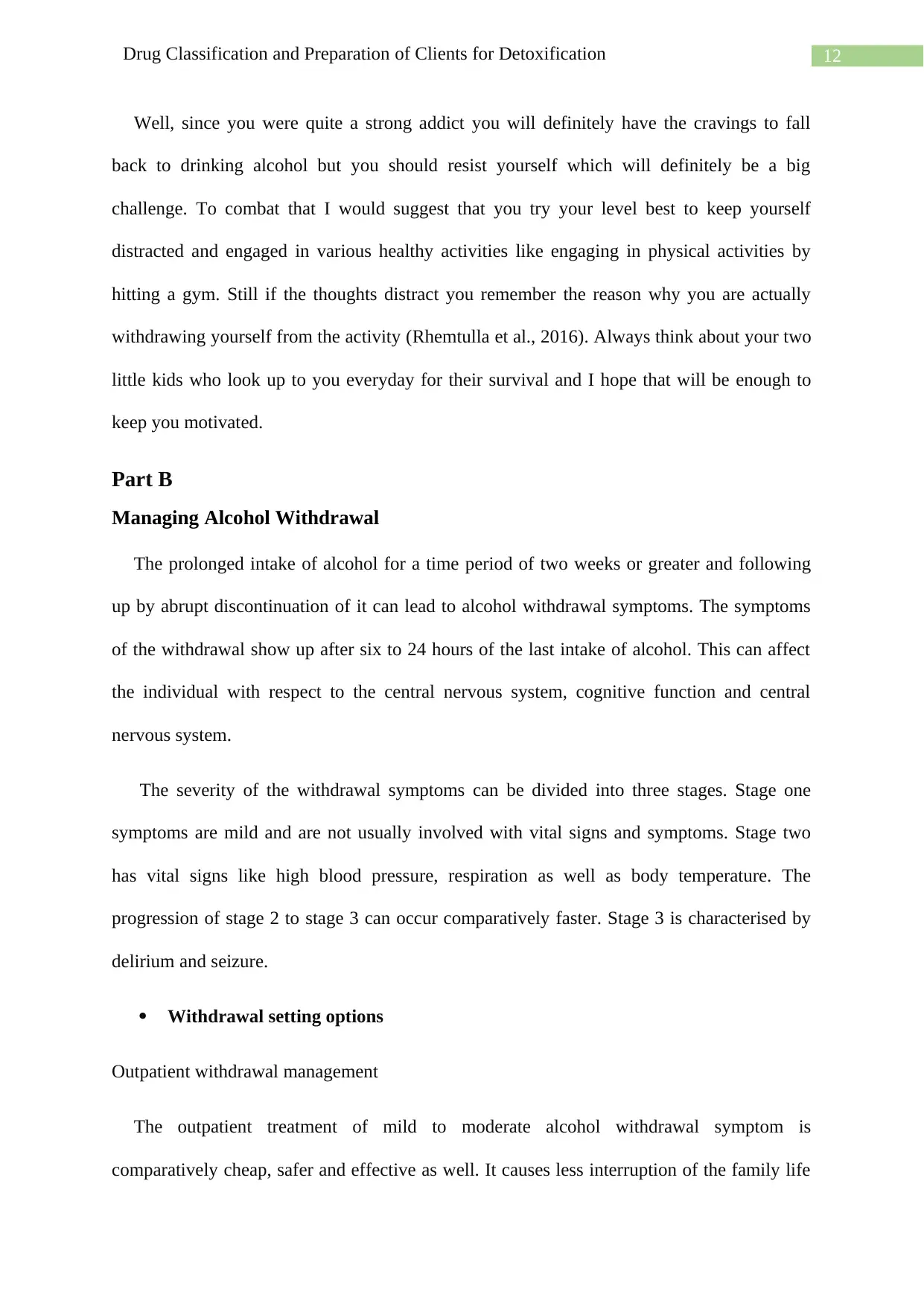
12Drug Classification and Preparation of Clients for Detoxification
Well, since you were quite a strong addict you will definitely have the cravings to fall
back to drinking alcohol but you should resist yourself which will definitely be a big
challenge. To combat that I would suggest that you try your level best to keep yourself
distracted and engaged in various healthy activities like engaging in physical activities by
hitting a gym. Still if the thoughts distract you remember the reason why you are actually
withdrawing yourself from the activity (Rhemtulla et al., 2016). Always think about your two
little kids who look up to you everyday for their survival and I hope that will be enough to
keep you motivated.
Part B
Managing Alcohol Withdrawal
The prolonged intake of alcohol for a time period of two weeks or greater and following
up by abrupt discontinuation of it can lead to alcohol withdrawal symptoms. The symptoms
of the withdrawal show up after six to 24 hours of the last intake of alcohol. This can affect
the individual with respect to the central nervous system, cognitive function and central
nervous system.
The severity of the withdrawal symptoms can be divided into three stages. Stage one
symptoms are mild and are not usually involved with vital signs and symptoms. Stage two
has vital signs like high blood pressure, respiration as well as body temperature. The
progression of stage 2 to stage 3 can occur comparatively faster. Stage 3 is characterised by
delirium and seizure.
Withdrawal setting options
Outpatient withdrawal management
The outpatient treatment of mild to moderate alcohol withdrawal symptom is
comparatively cheap, safer and effective as well. It causes less interruption of the family life
Well, since you were quite a strong addict you will definitely have the cravings to fall
back to drinking alcohol but you should resist yourself which will definitely be a big
challenge. To combat that I would suggest that you try your level best to keep yourself
distracted and engaged in various healthy activities like engaging in physical activities by
hitting a gym. Still if the thoughts distract you remember the reason why you are actually
withdrawing yourself from the activity (Rhemtulla et al., 2016). Always think about your two
little kids who look up to you everyday for their survival and I hope that will be enough to
keep you motivated.
Part B
Managing Alcohol Withdrawal
The prolonged intake of alcohol for a time period of two weeks or greater and following
up by abrupt discontinuation of it can lead to alcohol withdrawal symptoms. The symptoms
of the withdrawal show up after six to 24 hours of the last intake of alcohol. This can affect
the individual with respect to the central nervous system, cognitive function and central
nervous system.
The severity of the withdrawal symptoms can be divided into three stages. Stage one
symptoms are mild and are not usually involved with vital signs and symptoms. Stage two
has vital signs like high blood pressure, respiration as well as body temperature. The
progression of stage 2 to stage 3 can occur comparatively faster. Stage 3 is characterised by
delirium and seizure.
Withdrawal setting options
Outpatient withdrawal management
The outpatient treatment of mild to moderate alcohol withdrawal symptom is
comparatively cheap, safer and effective as well. It causes less interruption of the family life
Paraphrase This Document
Need a fresh take? Get an instant paraphrase of this document with our AI Paraphraser
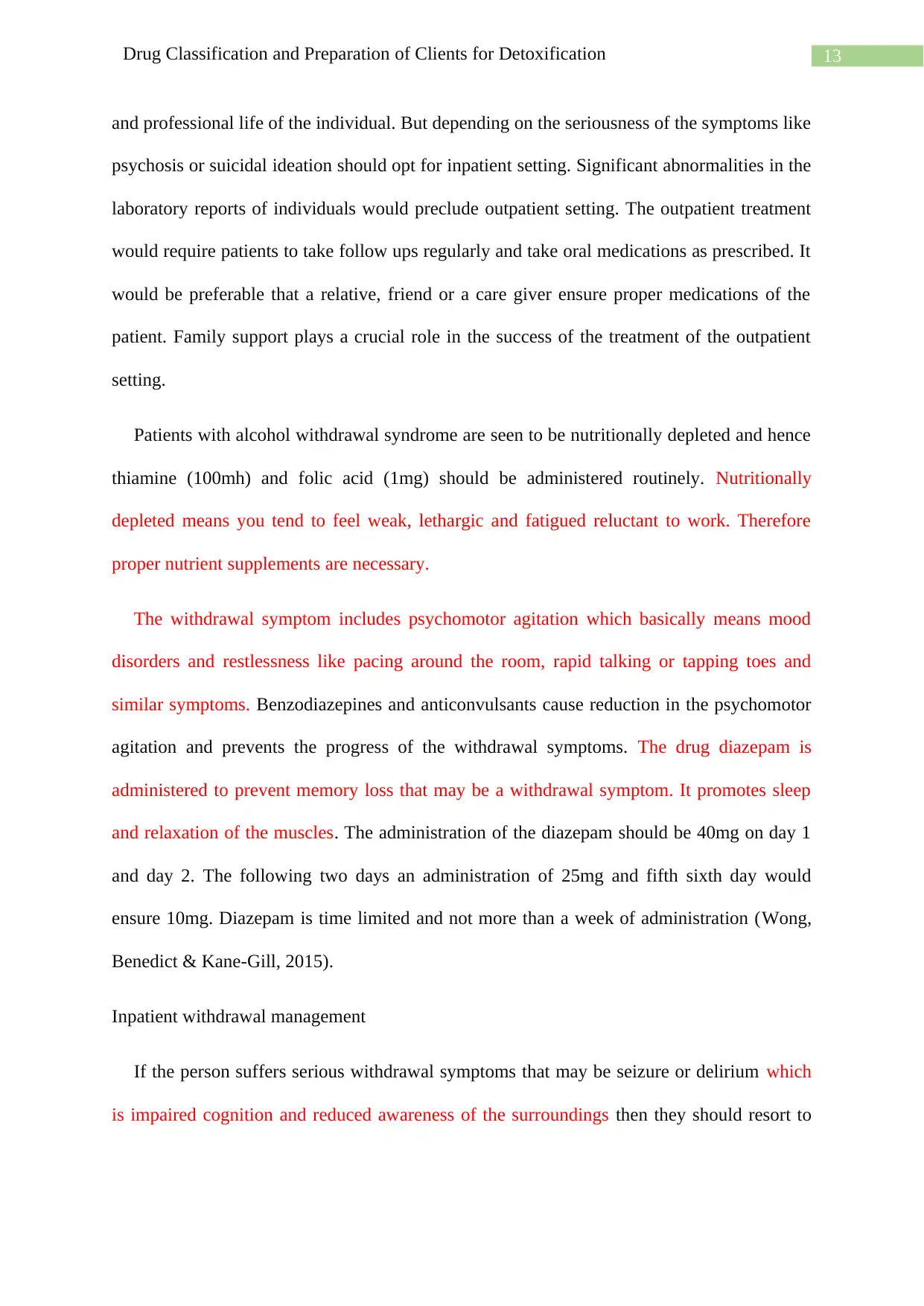
13Drug Classification and Preparation of Clients for Detoxification
and professional life of the individual. But depending on the seriousness of the symptoms like
psychosis or suicidal ideation should opt for inpatient setting. Significant abnormalities in the
laboratory reports of individuals would preclude outpatient setting. The outpatient treatment
would require patients to take follow ups regularly and take oral medications as prescribed. It
would be preferable that a relative, friend or a care giver ensure proper medications of the
patient. Family support plays a crucial role in the success of the treatment of the outpatient
setting.
Patients with alcohol withdrawal syndrome are seen to be nutritionally depleted and hence
thiamine (100mh) and folic acid (1mg) should be administered routinely. Nutritionally
depleted means you tend to feel weak, lethargic and fatigued reluctant to work. Therefore
proper nutrient supplements are necessary.
The withdrawal symptom includes psychomotor agitation which basically means mood
disorders and restlessness like pacing around the room, rapid talking or tapping toes and
similar symptoms. Benzodiazepines and anticonvulsants cause reduction in the psychomotor
agitation and prevents the progress of the withdrawal symptoms. The drug diazepam is
administered to prevent memory loss that may be a withdrawal symptom. It promotes sleep
and relaxation of the muscles. The administration of the diazepam should be 40mg on day 1
and day 2. The following two days an administration of 25mg and fifth sixth day would
ensure 10mg. Diazepam is time limited and not more than a week of administration (Wong,
Benedict & Kane-Gill, 2015).
Inpatient withdrawal management
If the person suffers serious withdrawal symptoms that may be seizure or delirium which
is impaired cognition and reduced awareness of the surroundings then they should resort to
and professional life of the individual. But depending on the seriousness of the symptoms like
psychosis or suicidal ideation should opt for inpatient setting. Significant abnormalities in the
laboratory reports of individuals would preclude outpatient setting. The outpatient treatment
would require patients to take follow ups regularly and take oral medications as prescribed. It
would be preferable that a relative, friend or a care giver ensure proper medications of the
patient. Family support plays a crucial role in the success of the treatment of the outpatient
setting.
Patients with alcohol withdrawal syndrome are seen to be nutritionally depleted and hence
thiamine (100mh) and folic acid (1mg) should be administered routinely. Nutritionally
depleted means you tend to feel weak, lethargic and fatigued reluctant to work. Therefore
proper nutrient supplements are necessary.
The withdrawal symptom includes psychomotor agitation which basically means mood
disorders and restlessness like pacing around the room, rapid talking or tapping toes and
similar symptoms. Benzodiazepines and anticonvulsants cause reduction in the psychomotor
agitation and prevents the progress of the withdrawal symptoms. The drug diazepam is
administered to prevent memory loss that may be a withdrawal symptom. It promotes sleep
and relaxation of the muscles. The administration of the diazepam should be 40mg on day 1
and day 2. The following two days an administration of 25mg and fifth sixth day would
ensure 10mg. Diazepam is time limited and not more than a week of administration (Wong,
Benedict & Kane-Gill, 2015).
Inpatient withdrawal management
If the person suffers serious withdrawal symptoms that may be seizure or delirium which
is impaired cognition and reduced awareness of the surroundings then they should resort to
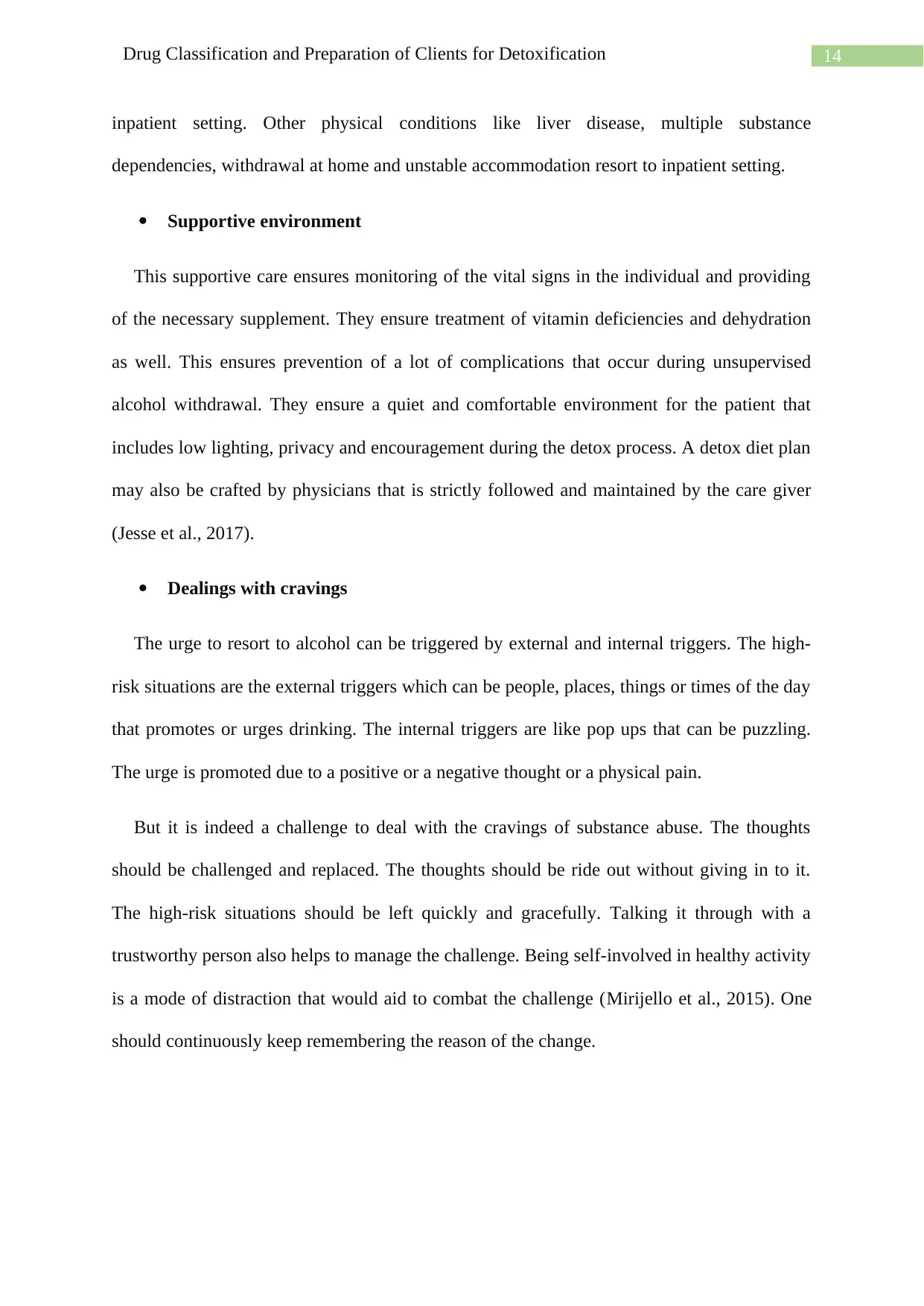
14Drug Classification and Preparation of Clients for Detoxification
inpatient setting. Other physical conditions like liver disease, multiple substance
dependencies, withdrawal at home and unstable accommodation resort to inpatient setting.
Supportive environment
This supportive care ensures monitoring of the vital signs in the individual and providing
of the necessary supplement. They ensure treatment of vitamin deficiencies and dehydration
as well. This ensures prevention of a lot of complications that occur during unsupervised
alcohol withdrawal. They ensure a quiet and comfortable environment for the patient that
includes low lighting, privacy and encouragement during the detox process. A detox diet plan
may also be crafted by physicians that is strictly followed and maintained by the care giver
(Jesse et al., 2017).
Dealings with cravings
The urge to resort to alcohol can be triggered by external and internal triggers. The high-
risk situations are the external triggers which can be people, places, things or times of the day
that promotes or urges drinking. The internal triggers are like pop ups that can be puzzling.
The urge is promoted due to a positive or a negative thought or a physical pain.
But it is indeed a challenge to deal with the cravings of substance abuse. The thoughts
should be challenged and replaced. The thoughts should be ride out without giving in to it.
The high-risk situations should be left quickly and gracefully. Talking it through with a
trustworthy person also helps to manage the challenge. Being self-involved in healthy activity
is a mode of distraction that would aid to combat the challenge (Mirijello et al., 2015). One
should continuously keep remembering the reason of the change.
inpatient setting. Other physical conditions like liver disease, multiple substance
dependencies, withdrawal at home and unstable accommodation resort to inpatient setting.
Supportive environment
This supportive care ensures monitoring of the vital signs in the individual and providing
of the necessary supplement. They ensure treatment of vitamin deficiencies and dehydration
as well. This ensures prevention of a lot of complications that occur during unsupervised
alcohol withdrawal. They ensure a quiet and comfortable environment for the patient that
includes low lighting, privacy and encouragement during the detox process. A detox diet plan
may also be crafted by physicians that is strictly followed and maintained by the care giver
(Jesse et al., 2017).
Dealings with cravings
The urge to resort to alcohol can be triggered by external and internal triggers. The high-
risk situations are the external triggers which can be people, places, things or times of the day
that promotes or urges drinking. The internal triggers are like pop ups that can be puzzling.
The urge is promoted due to a positive or a negative thought or a physical pain.
But it is indeed a challenge to deal with the cravings of substance abuse. The thoughts
should be challenged and replaced. The thoughts should be ride out without giving in to it.
The high-risk situations should be left quickly and gracefully. Talking it through with a
trustworthy person also helps to manage the challenge. Being self-involved in healthy activity
is a mode of distraction that would aid to combat the challenge (Mirijello et al., 2015). One
should continuously keep remembering the reason of the change.

15Drug Classification and Preparation of Clients for Detoxification
References
Jackson, E. R., Shanafelt, T. D., Hasan, O., Satele, D. V., & Dyrbye, L. N. (2016). Burnout
and alcohol abuse/dependence among US medical students. Academic Medicine, 91(9),
1251-1256.
Jesse, S., Bråthen, G., Ferrara, M., Keindl, M., Ben‐Menachem, E., Tanasescu, R., ... &
Ludolph, A. C. (2017). Alcohol withdrawal syndrome: mechanisms, manifestations, and
management. Acta Neurologica Scandinavica, 135(1), 4-16.
Lago, L., Glantz, M. D., Kessler, R. C., Sampson, N. A., Al‐Hamzawi, A., Florescu, S., ... &
Viana, M. C. (2017). Substance dependence among those without symptoms of substance
abuse in the World Mental Health Survey. International journal of methods in psychiatric
research, 26(3), e1557.
Mirijello, A., D’Angelo, C., Ferrulli, A., Vassallo, G., Antonelli, M., Caputo, F., ... &
Addolorato, G. (2015). Identification and management of alcohol withdrawal
syndrome. Drugs, 75(4), 353-365.
Rhemtulla, M., Fried, E. I., Aggen, S. H., Tuerlinckx, F., Kendler, K. S., & Borsboom, D.
(2016). Network analysis of substance abuse and dependence symptoms. Drug and
alcohol dependence, 161, 230-237.
Wong, A., Benedict, N. J., & Kane-Gill, S. L. (2015). Multicenter evaluation of
pharmacologic management and outcomes associated with severe resistant alcohol
withdrawal. Journal of critical care, 30(2), 405-409.
References
Jackson, E. R., Shanafelt, T. D., Hasan, O., Satele, D. V., & Dyrbye, L. N. (2016). Burnout
and alcohol abuse/dependence among US medical students. Academic Medicine, 91(9),
1251-1256.
Jesse, S., Bråthen, G., Ferrara, M., Keindl, M., Ben‐Menachem, E., Tanasescu, R., ... &
Ludolph, A. C. (2017). Alcohol withdrawal syndrome: mechanisms, manifestations, and
management. Acta Neurologica Scandinavica, 135(1), 4-16.
Lago, L., Glantz, M. D., Kessler, R. C., Sampson, N. A., Al‐Hamzawi, A., Florescu, S., ... &
Viana, M. C. (2017). Substance dependence among those without symptoms of substance
abuse in the World Mental Health Survey. International journal of methods in psychiatric
research, 26(3), e1557.
Mirijello, A., D’Angelo, C., Ferrulli, A., Vassallo, G., Antonelli, M., Caputo, F., ... &
Addolorato, G. (2015). Identification and management of alcohol withdrawal
syndrome. Drugs, 75(4), 353-365.
Rhemtulla, M., Fried, E. I., Aggen, S. H., Tuerlinckx, F., Kendler, K. S., & Borsboom, D.
(2016). Network analysis of substance abuse and dependence symptoms. Drug and
alcohol dependence, 161, 230-237.
Wong, A., Benedict, N. J., & Kane-Gill, S. L. (2015). Multicenter evaluation of
pharmacologic management and outcomes associated with severe resistant alcohol
withdrawal. Journal of critical care, 30(2), 405-409.
Secure Best Marks with AI Grader
Need help grading? Try our AI Grader for instant feedback on your assignments.
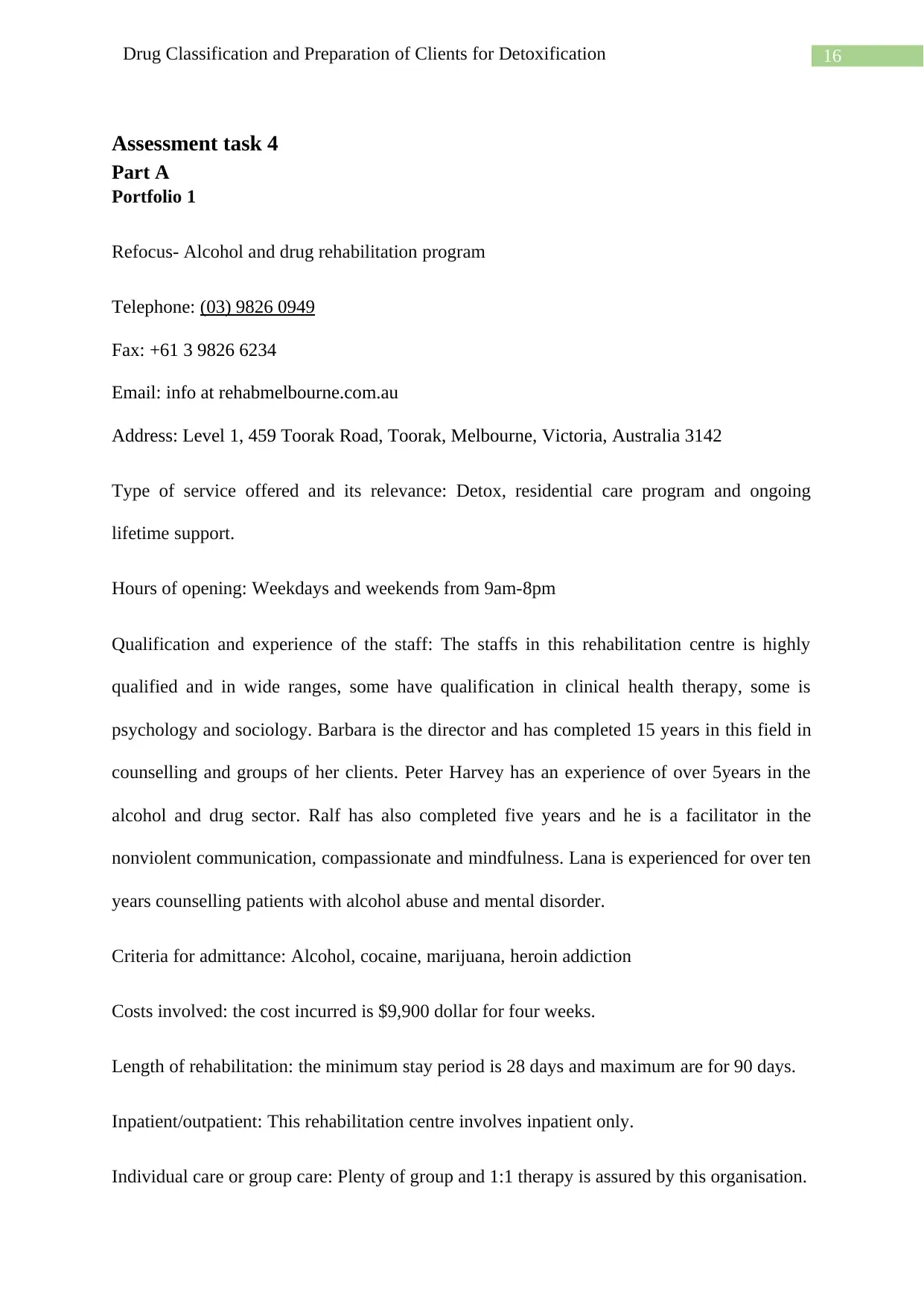
16Drug Classification and Preparation of Clients for Detoxification
Assessment task 4
Part A
Portfolio 1
Refocus- Alcohol and drug rehabilitation program
Telephone: (03) 9826 0949
Fax: +61 3 9826 6234
Email: info at rehabmelbourne.com.au
Address: Level 1, 459 Toorak Road, Toorak, Melbourne, Victoria, Australia 3142
Type of service offered and its relevance: Detox, residential care program and ongoing
lifetime support.
Hours of opening: Weekdays and weekends from 9am-8pm
Qualification and experience of the staff: The staffs in this rehabilitation centre is highly
qualified and in wide ranges, some have qualification in clinical health therapy, some is
psychology and sociology. Barbara is the director and has completed 15 years in this field in
counselling and groups of her clients. Peter Harvey has an experience of over 5years in the
alcohol and drug sector. Ralf has also completed five years and he is a facilitator in the
nonviolent communication, compassionate and mindfulness. Lana is experienced for over ten
years counselling patients with alcohol abuse and mental disorder.
Criteria for admittance: Alcohol, cocaine, marijuana, heroin addiction
Costs involved: the cost incurred is $9,900 dollar for four weeks.
Length of rehabilitation: the minimum stay period is 28 days and maximum are for 90 days.
Inpatient/outpatient: This rehabilitation centre involves inpatient only.
Individual care or group care: Plenty of group and 1:1 therapy is assured by this organisation.
Assessment task 4
Part A
Portfolio 1
Refocus- Alcohol and drug rehabilitation program
Telephone: (03) 9826 0949
Fax: +61 3 9826 6234
Email: info at rehabmelbourne.com.au
Address: Level 1, 459 Toorak Road, Toorak, Melbourne, Victoria, Australia 3142
Type of service offered and its relevance: Detox, residential care program and ongoing
lifetime support.
Hours of opening: Weekdays and weekends from 9am-8pm
Qualification and experience of the staff: The staffs in this rehabilitation centre is highly
qualified and in wide ranges, some have qualification in clinical health therapy, some is
psychology and sociology. Barbara is the director and has completed 15 years in this field in
counselling and groups of her clients. Peter Harvey has an experience of over 5years in the
alcohol and drug sector. Ralf has also completed five years and he is a facilitator in the
nonviolent communication, compassionate and mindfulness. Lana is experienced for over ten
years counselling patients with alcohol abuse and mental disorder.
Criteria for admittance: Alcohol, cocaine, marijuana, heroin addiction
Costs involved: the cost incurred is $9,900 dollar for four weeks.
Length of rehabilitation: the minimum stay period is 28 days and maximum are for 90 days.
Inpatient/outpatient: This rehabilitation centre involves inpatient only.
Individual care or group care: Plenty of group and 1:1 therapy is assured by this organisation.
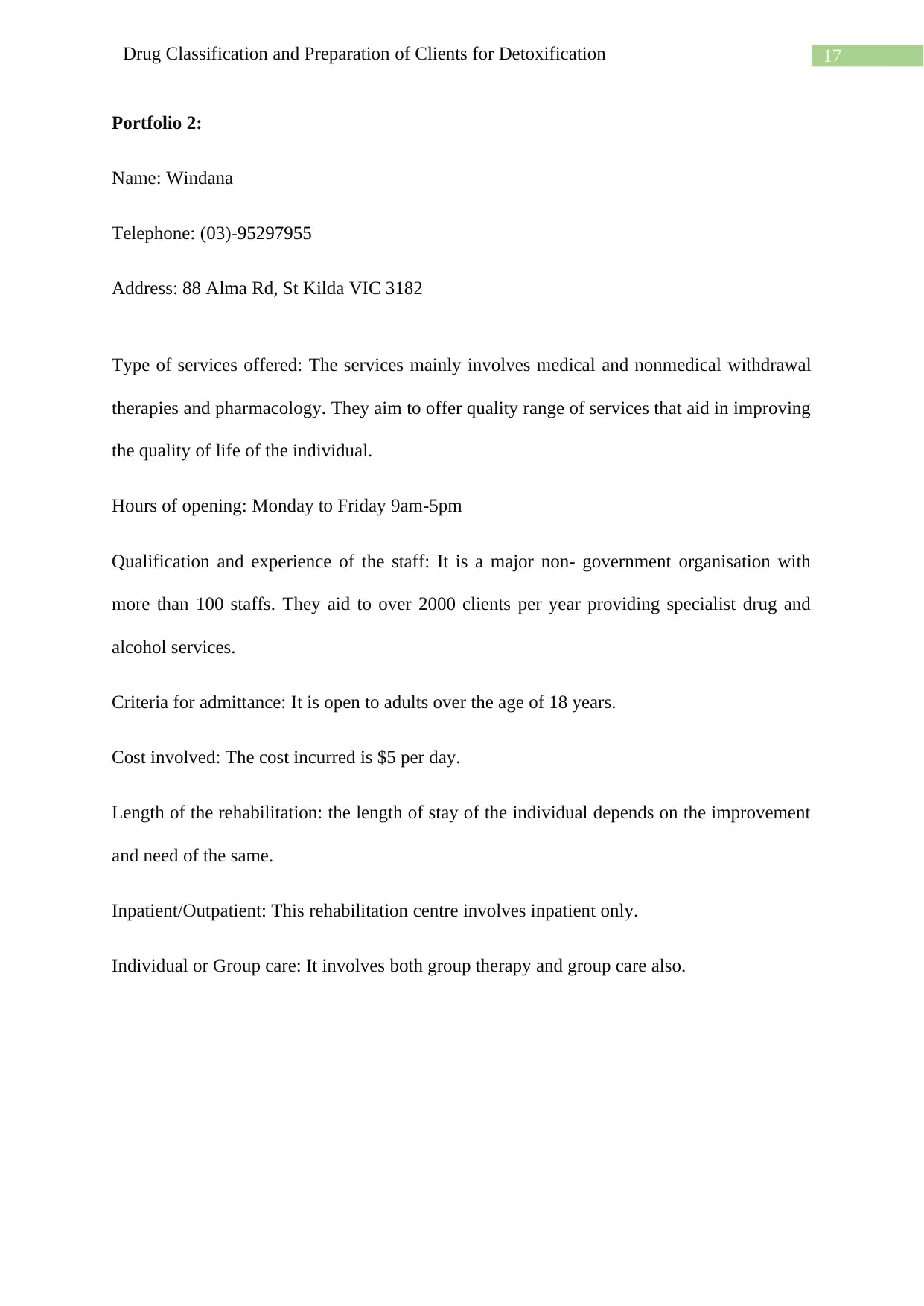
17Drug Classification and Preparation of Clients for Detoxification
Portfolio 2:
Name: Windana
Telephone: (03)-95297955
Address: 88 Alma Rd, St Kilda VIC 3182
Type of services offered: The services mainly involves medical and nonmedical withdrawal
therapies and pharmacology. They aim to offer quality range of services that aid in improving
the quality of life of the individual.
Hours of opening: Monday to Friday 9am-5pm
Qualification and experience of the staff: It is a major non- government organisation with
more than 100 staffs. They aid to over 2000 clients per year providing specialist drug and
alcohol services.
Criteria for admittance: It is open to adults over the age of 18 years.
Cost involved: The cost incurred is $5 per day.
Length of the rehabilitation: the length of stay of the individual depends on the improvement
and need of the same.
Inpatient/Outpatient: This rehabilitation centre involves inpatient only.
Individual or Group care: It involves both group therapy and group care also.
Portfolio 2:
Name: Windana
Telephone: (03)-95297955
Address: 88 Alma Rd, St Kilda VIC 3182
Type of services offered: The services mainly involves medical and nonmedical withdrawal
therapies and pharmacology. They aim to offer quality range of services that aid in improving
the quality of life of the individual.
Hours of opening: Monday to Friday 9am-5pm
Qualification and experience of the staff: It is a major non- government organisation with
more than 100 staffs. They aid to over 2000 clients per year providing specialist drug and
alcohol services.
Criteria for admittance: It is open to adults over the age of 18 years.
Cost involved: The cost incurred is $5 per day.
Length of the rehabilitation: the length of stay of the individual depends on the improvement
and need of the same.
Inpatient/Outpatient: This rehabilitation centre involves inpatient only.
Individual or Group care: It involves both group therapy and group care also.
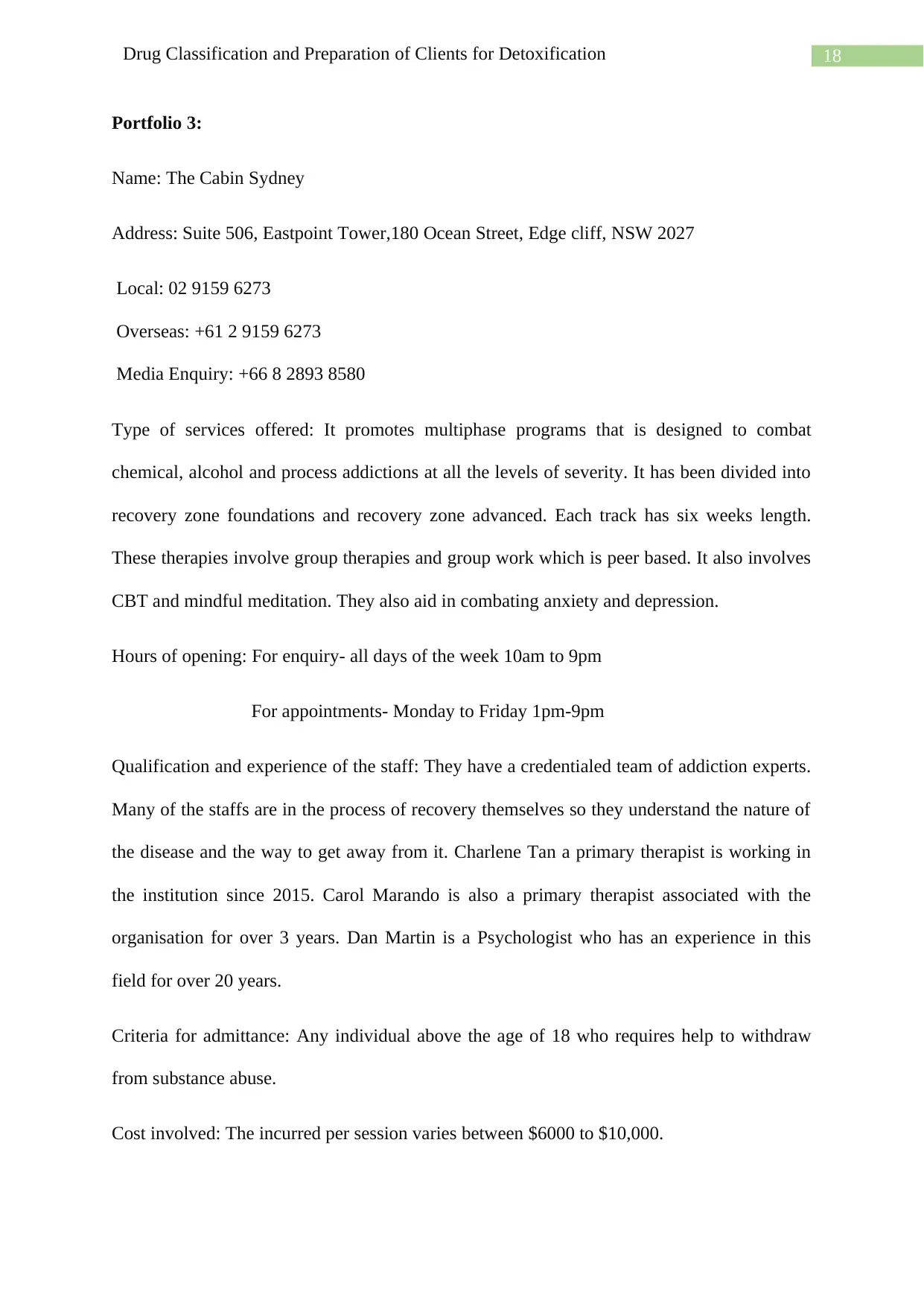
18Drug Classification and Preparation of Clients for Detoxification
Portfolio 3:
Name: The Cabin Sydney
Address: Suite 506, Eastpoint Tower,180 Ocean Street, Edge cliff, NSW 2027
Local: 02 9159 6273
Overseas: +61 2 9159 6273
Media Enquiry: +66 8 2893 8580
Type of services offered: It promotes multiphase programs that is designed to combat
chemical, alcohol and process addictions at all the levels of severity. It has been divided into
recovery zone foundations and recovery zone advanced. Each track has six weeks length.
These therapies involve group therapies and group work which is peer based. It also involves
CBT and mindful meditation. They also aid in combating anxiety and depression.
Hours of opening: For enquiry- all days of the week 10am to 9pm
For appointments- Monday to Friday 1pm-9pm
Qualification and experience of the staff: They have a credentialed team of addiction experts.
Many of the staffs are in the process of recovery themselves so they understand the nature of
the disease and the way to get away from it. Charlene Tan a primary therapist is working in
the institution since 2015. Carol Marando is also a primary therapist associated with the
organisation for over 3 years. Dan Martin is a Psychologist who has an experience in this
field for over 20 years.
Criteria for admittance: Any individual above the age of 18 who requires help to withdraw
from substance abuse.
Cost involved: The incurred per session varies between $6000 to $10,000.
Portfolio 3:
Name: The Cabin Sydney
Address: Suite 506, Eastpoint Tower,180 Ocean Street, Edge cliff, NSW 2027
Local: 02 9159 6273
Overseas: +61 2 9159 6273
Media Enquiry: +66 8 2893 8580
Type of services offered: It promotes multiphase programs that is designed to combat
chemical, alcohol and process addictions at all the levels of severity. It has been divided into
recovery zone foundations and recovery zone advanced. Each track has six weeks length.
These therapies involve group therapies and group work which is peer based. It also involves
CBT and mindful meditation. They also aid in combating anxiety and depression.
Hours of opening: For enquiry- all days of the week 10am to 9pm
For appointments- Monday to Friday 1pm-9pm
Qualification and experience of the staff: They have a credentialed team of addiction experts.
Many of the staffs are in the process of recovery themselves so they understand the nature of
the disease and the way to get away from it. Charlene Tan a primary therapist is working in
the institution since 2015. Carol Marando is also a primary therapist associated with the
organisation for over 3 years. Dan Martin is a Psychologist who has an experience in this
field for over 20 years.
Criteria for admittance: Any individual above the age of 18 who requires help to withdraw
from substance abuse.
Cost involved: The incurred per session varies between $6000 to $10,000.
Paraphrase This Document
Need a fresh take? Get an instant paraphrase of this document with our AI Paraphraser

19Drug Classification and Preparation of Clients for Detoxification
Length of the rehabilitation: Approximately 90 days. May extend based on the needs of the
individual.
Inpatient/Outpatient: They provide both inpatient and outpatient services. This organization is
an extension of the proven outpatient programs.
Individual or Group care: They provide both group care as well as individual care.
Length of the rehabilitation: Approximately 90 days. May extend based on the needs of the
individual.
Inpatient/Outpatient: They provide both inpatient and outpatient services. This organization is
an extension of the proven outpatient programs.
Individual or Group care: They provide both group care as well as individual care.
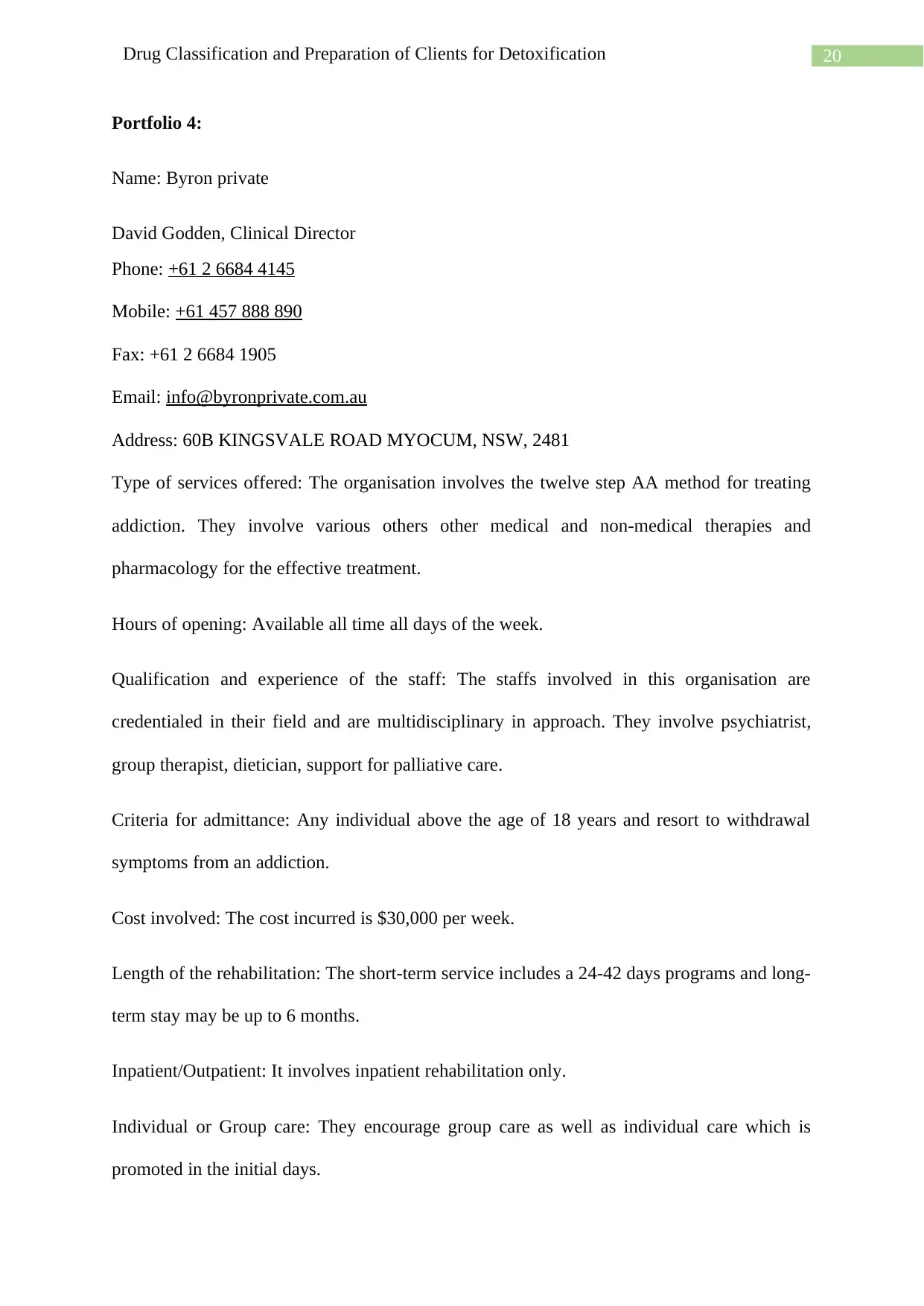
20Drug Classification and Preparation of Clients for Detoxification
Portfolio 4:
Name: Byron private
David Godden, Clinical Director
Phone: +61 2 6684 4145
Mobile: +61 457 888 890
Fax: +61 2 6684 1905
Email: info@byronprivate.com.au
Address: 60B KINGSVALE ROAD MYOCUM, NSW, 2481
Type of services offered: The organisation involves the twelve step AA method for treating
addiction. They involve various others other medical and non-medical therapies and
pharmacology for the effective treatment.
Hours of opening: Available all time all days of the week.
Qualification and experience of the staff: The staffs involved in this organisation are
credentialed in their field and are multidisciplinary in approach. They involve psychiatrist,
group therapist, dietician, support for palliative care.
Criteria for admittance: Any individual above the age of 18 years and resort to withdrawal
symptoms from an addiction.
Cost involved: The cost incurred is $30,000 per week.
Length of the rehabilitation: The short-term service includes a 24-42 days programs and long-
term stay may be up to 6 months.
Inpatient/Outpatient: It involves inpatient rehabilitation only.
Individual or Group care: They encourage group care as well as individual care which is
promoted in the initial days.
Portfolio 4:
Name: Byron private
David Godden, Clinical Director
Phone: +61 2 6684 4145
Mobile: +61 457 888 890
Fax: +61 2 6684 1905
Email: info@byronprivate.com.au
Address: 60B KINGSVALE ROAD MYOCUM, NSW, 2481
Type of services offered: The organisation involves the twelve step AA method for treating
addiction. They involve various others other medical and non-medical therapies and
pharmacology for the effective treatment.
Hours of opening: Available all time all days of the week.
Qualification and experience of the staff: The staffs involved in this organisation are
credentialed in their field and are multidisciplinary in approach. They involve psychiatrist,
group therapist, dietician, support for palliative care.
Criteria for admittance: Any individual above the age of 18 years and resort to withdrawal
symptoms from an addiction.
Cost involved: The cost incurred is $30,000 per week.
Length of the rehabilitation: The short-term service includes a 24-42 days programs and long-
term stay may be up to 6 months.
Inpatient/Outpatient: It involves inpatient rehabilitation only.
Individual or Group care: They encourage group care as well as individual care which is
promoted in the initial days.
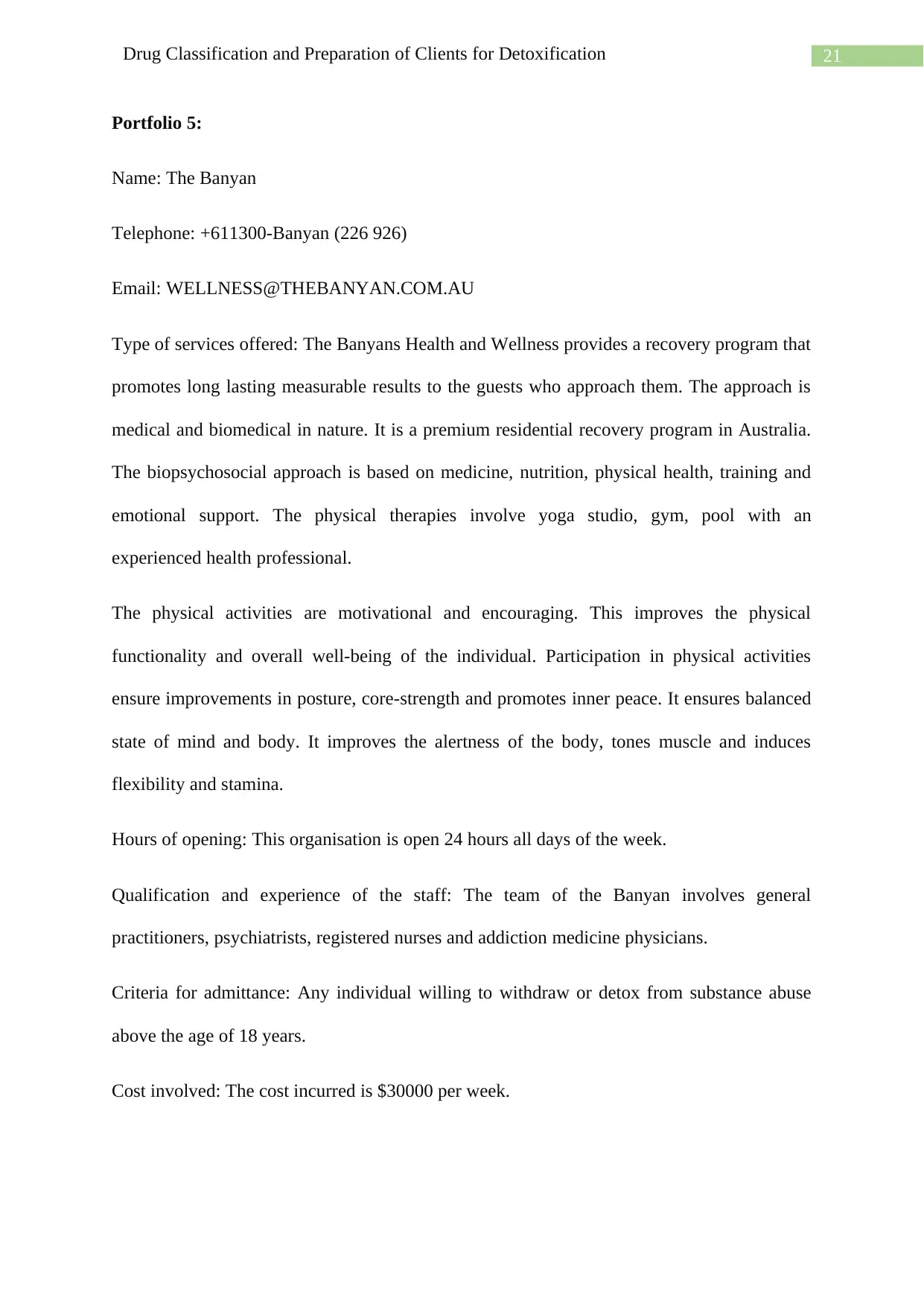
21Drug Classification and Preparation of Clients for Detoxification
Portfolio 5:
Name: The Banyan
Telephone: +611300-Banyan (226 926)
Email: WELLNESS@THEBANYAN.COM.AU
Type of services offered: The Banyans Health and Wellness provides a recovery program that
promotes long lasting measurable results to the guests who approach them. The approach is
medical and biomedical in nature. It is a premium residential recovery program in Australia.
The biopsychosocial approach is based on medicine, nutrition, physical health, training and
emotional support. The physical therapies involve yoga studio, gym, pool with an
experienced health professional.
The physical activities are motivational and encouraging. This improves the physical
functionality and overall well-being of the individual. Participation in physical activities
ensure improvements in posture, core-strength and promotes inner peace. It ensures balanced
state of mind and body. It improves the alertness of the body, tones muscle and induces
flexibility and stamina.
Hours of opening: This organisation is open 24 hours all days of the week.
Qualification and experience of the staff: The team of the Banyan involves general
practitioners, psychiatrists, registered nurses and addiction medicine physicians.
Criteria for admittance: Any individual willing to withdraw or detox from substance abuse
above the age of 18 years.
Cost involved: The cost incurred is $30000 per week.
Portfolio 5:
Name: The Banyan
Telephone: +611300-Banyan (226 926)
Email: WELLNESS@THEBANYAN.COM.AU
Type of services offered: The Banyans Health and Wellness provides a recovery program that
promotes long lasting measurable results to the guests who approach them. The approach is
medical and biomedical in nature. It is a premium residential recovery program in Australia.
The biopsychosocial approach is based on medicine, nutrition, physical health, training and
emotional support. The physical therapies involve yoga studio, gym, pool with an
experienced health professional.
The physical activities are motivational and encouraging. This improves the physical
functionality and overall well-being of the individual. Participation in physical activities
ensure improvements in posture, core-strength and promotes inner peace. It ensures balanced
state of mind and body. It improves the alertness of the body, tones muscle and induces
flexibility and stamina.
Hours of opening: This organisation is open 24 hours all days of the week.
Qualification and experience of the staff: The team of the Banyan involves general
practitioners, psychiatrists, registered nurses and addiction medicine physicians.
Criteria for admittance: Any individual willing to withdraw or detox from substance abuse
above the age of 18 years.
Cost involved: The cost incurred is $30000 per week.
Secure Best Marks with AI Grader
Need help grading? Try our AI Grader for instant feedback on your assignments.
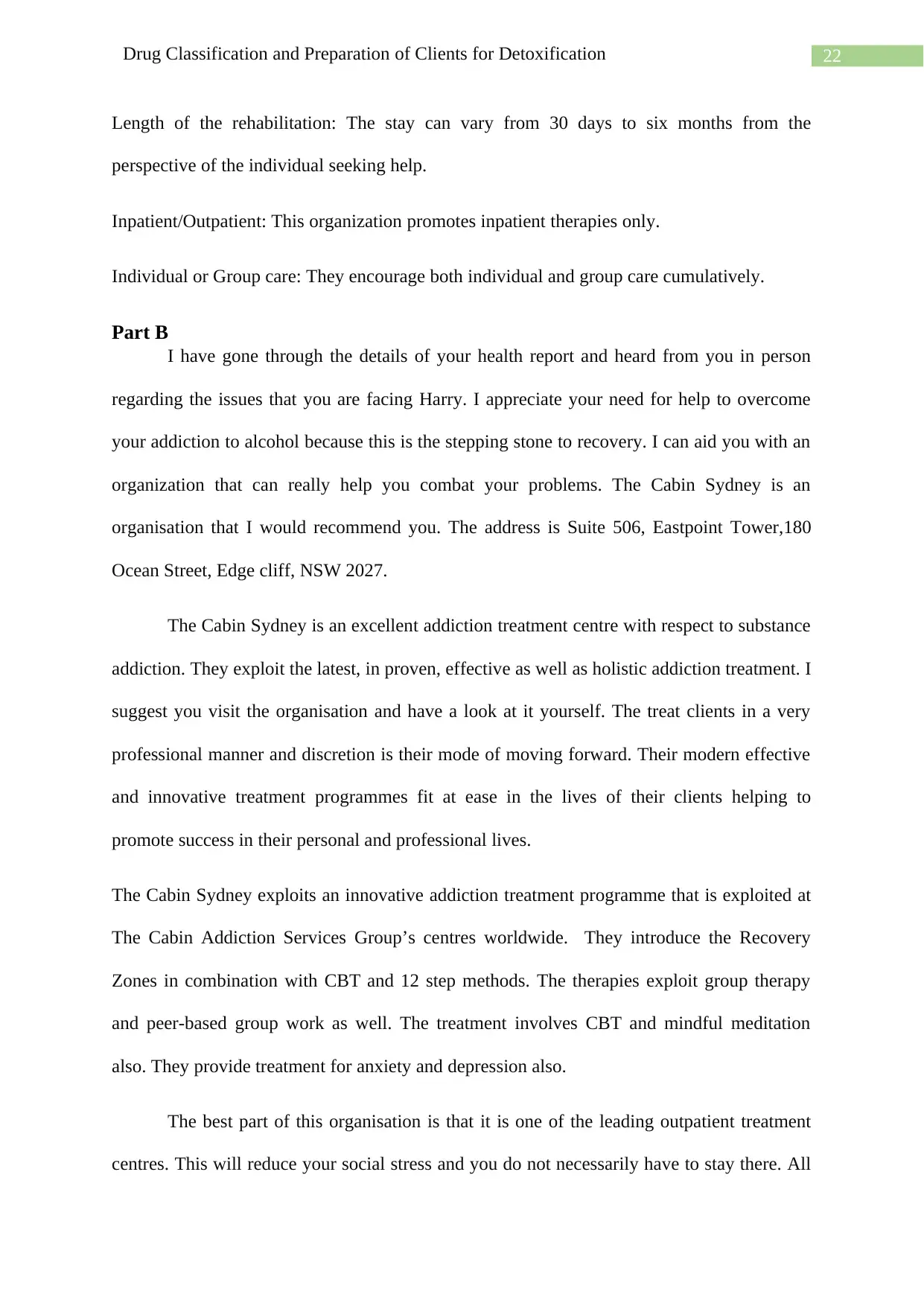
22Drug Classification and Preparation of Clients for Detoxification
Length of the rehabilitation: The stay can vary from 30 days to six months from the
perspective of the individual seeking help.
Inpatient/Outpatient: This organization promotes inpatient therapies only.
Individual or Group care: They encourage both individual and group care cumulatively.
Part B
I have gone through the details of your health report and heard from you in person
regarding the issues that you are facing Harry. I appreciate your need for help to overcome
your addiction to alcohol because this is the stepping stone to recovery. I can aid you with an
organization that can really help you combat your problems. The Cabin Sydney is an
organisation that I would recommend you. The address is Suite 506, Eastpoint Tower,180
Ocean Street, Edge cliff, NSW 2027.
The Cabin Sydney is an excellent addiction treatment centre with respect to substance
addiction. They exploit the latest, in proven, effective as well as holistic addiction treatment. I
suggest you visit the organisation and have a look at it yourself. The treat clients in a very
professional manner and discretion is their mode of moving forward. Their modern effective
and innovative treatment programmes fit at ease in the lives of their clients helping to
promote success in their personal and professional lives.
The Cabin Sydney exploits an innovative addiction treatment programme that is exploited at
The Cabin Addiction Services Group’s centres worldwide. They introduce the Recovery
Zones in combination with CBT and 12 step methods. The therapies exploit group therapy
and peer-based group work as well. The treatment involves CBT and mindful meditation
also. They provide treatment for anxiety and depression also.
The best part of this organisation is that it is one of the leading outpatient treatment
centres. This will reduce your social stress and you do not necessarily have to stay there. All
Length of the rehabilitation: The stay can vary from 30 days to six months from the
perspective of the individual seeking help.
Inpatient/Outpatient: This organization promotes inpatient therapies only.
Individual or Group care: They encourage both individual and group care cumulatively.
Part B
I have gone through the details of your health report and heard from you in person
regarding the issues that you are facing Harry. I appreciate your need for help to overcome
your addiction to alcohol because this is the stepping stone to recovery. I can aid you with an
organization that can really help you combat your problems. The Cabin Sydney is an
organisation that I would recommend you. The address is Suite 506, Eastpoint Tower,180
Ocean Street, Edge cliff, NSW 2027.
The Cabin Sydney is an excellent addiction treatment centre with respect to substance
addiction. They exploit the latest, in proven, effective as well as holistic addiction treatment. I
suggest you visit the organisation and have a look at it yourself. The treat clients in a very
professional manner and discretion is their mode of moving forward. Their modern effective
and innovative treatment programmes fit at ease in the lives of their clients helping to
promote success in their personal and professional lives.
The Cabin Sydney exploits an innovative addiction treatment programme that is exploited at
The Cabin Addiction Services Group’s centres worldwide. They introduce the Recovery
Zones in combination with CBT and 12 step methods. The therapies exploit group therapy
and peer-based group work as well. The treatment involves CBT and mindful meditation
also. They provide treatment for anxiety and depression also.
The best part of this organisation is that it is one of the leading outpatient treatment
centres. This will reduce your social stress and you do not necessarily have to stay there. All
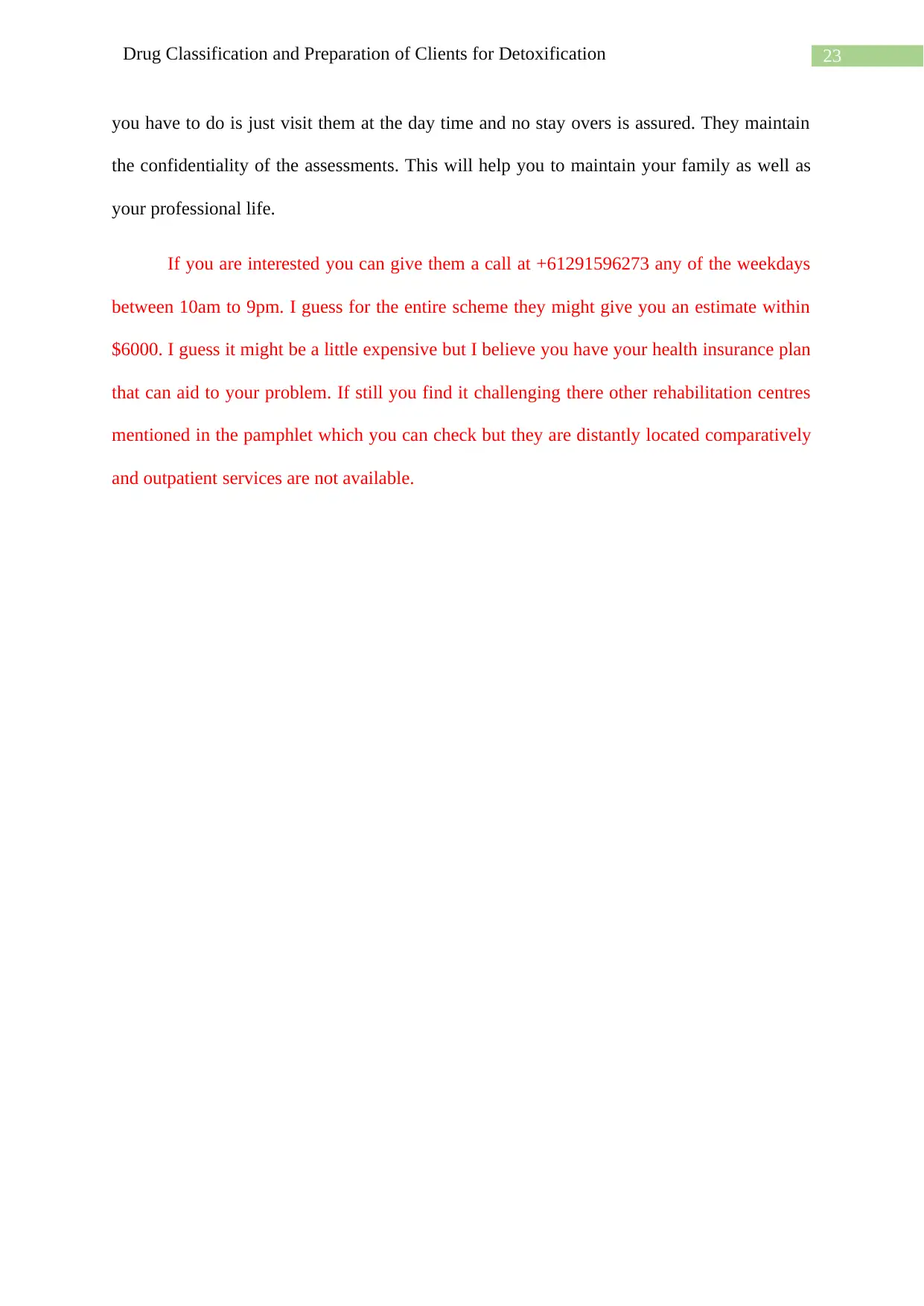
23Drug Classification and Preparation of Clients for Detoxification
you have to do is just visit them at the day time and no stay overs is assured. They maintain
the confidentiality of the assessments. This will help you to maintain your family as well as
your professional life.
If you are interested you can give them a call at +61291596273 any of the weekdays
between 10am to 9pm. I guess for the entire scheme they might give you an estimate within
$6000. I guess it might be a little expensive but I believe you have your health insurance plan
that can aid to your problem. If still you find it challenging there other rehabilitation centres
mentioned in the pamphlet which you can check but they are distantly located comparatively
and outpatient services are not available.
you have to do is just visit them at the day time and no stay overs is assured. They maintain
the confidentiality of the assessments. This will help you to maintain your family as well as
your professional life.
If you are interested you can give them a call at +61291596273 any of the weekdays
between 10am to 9pm. I guess for the entire scheme they might give you an estimate within
$6000. I guess it might be a little expensive but I believe you have your health insurance plan
that can aid to your problem. If still you find it challenging there other rehabilitation centres
mentioned in the pamphlet which you can check but they are distantly located comparatively
and outpatient services are not available.
1 out of 24
Your All-in-One AI-Powered Toolkit for Academic Success.
+13062052269
info@desklib.com
Available 24*7 on WhatsApp / Email
![[object Object]](/_next/static/media/star-bottom.7253800d.svg)
Unlock your academic potential
© 2024 | Zucol Services PVT LTD | All rights reserved.

